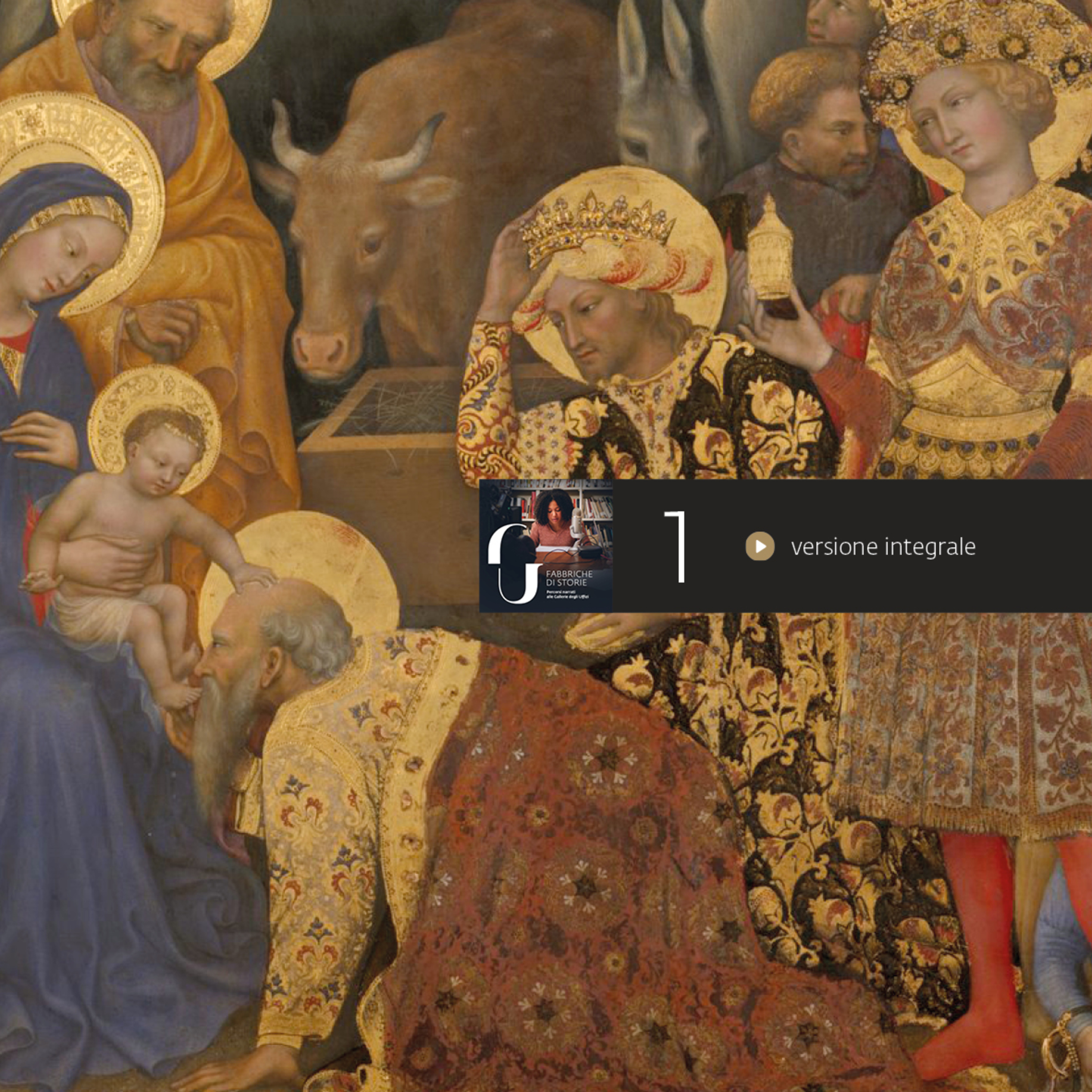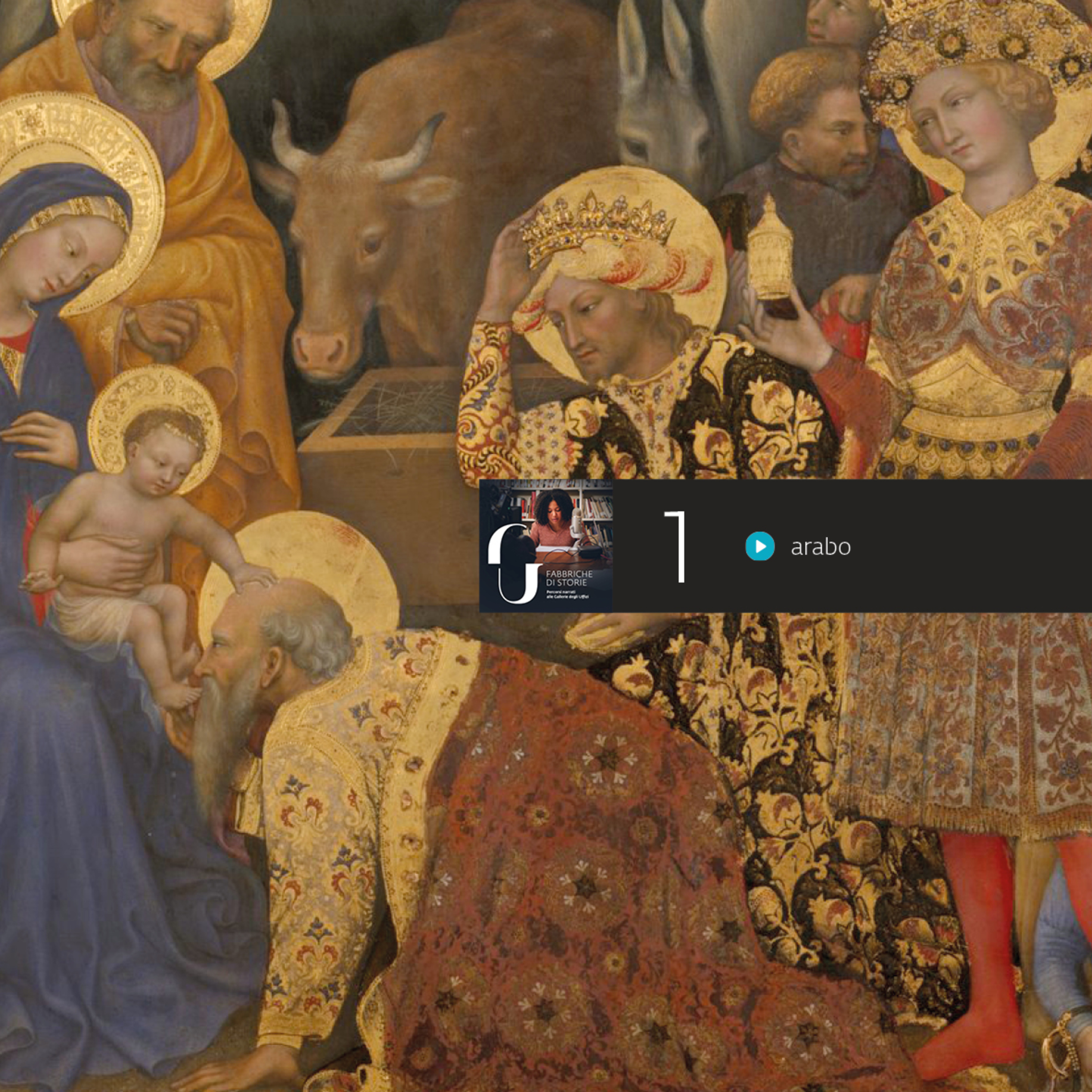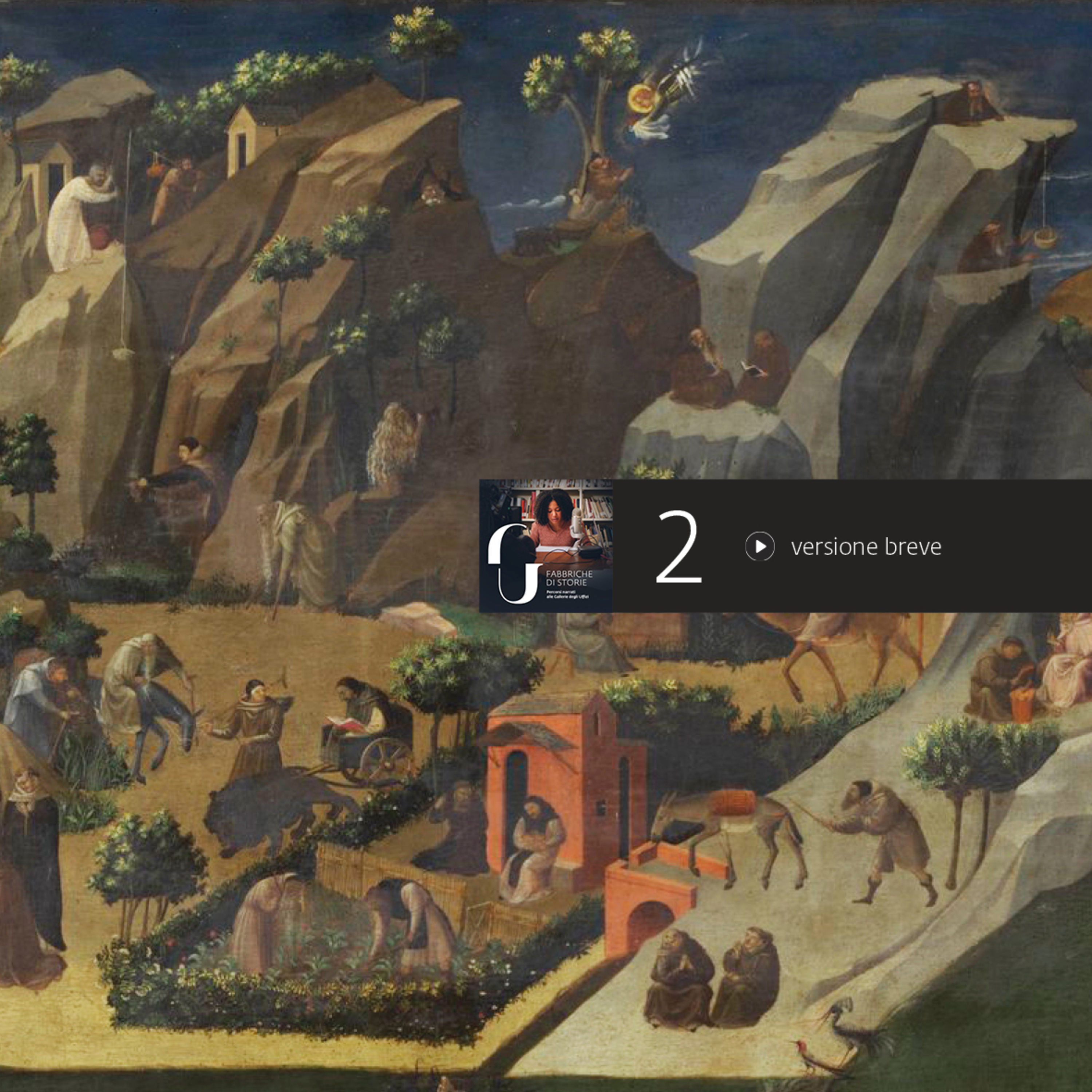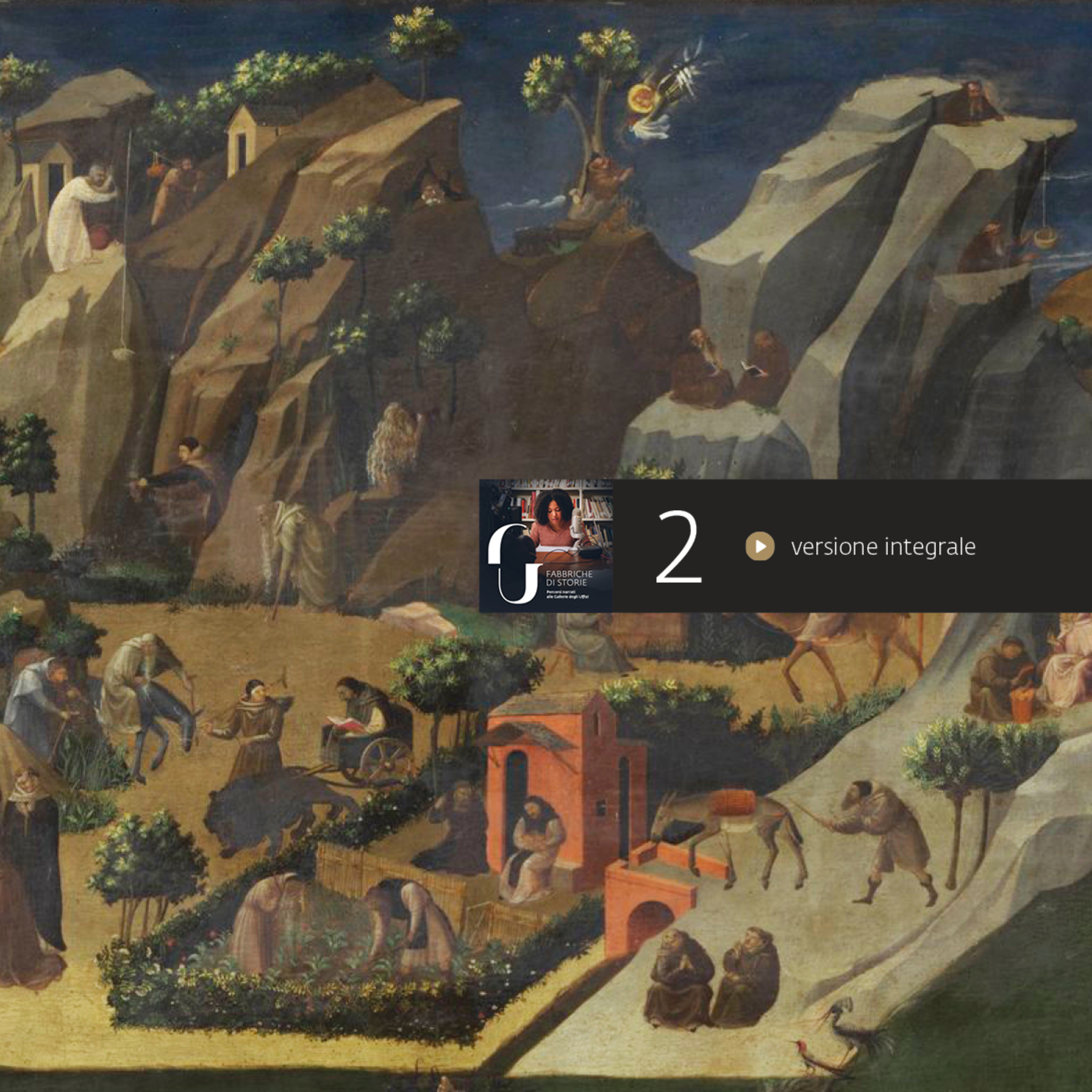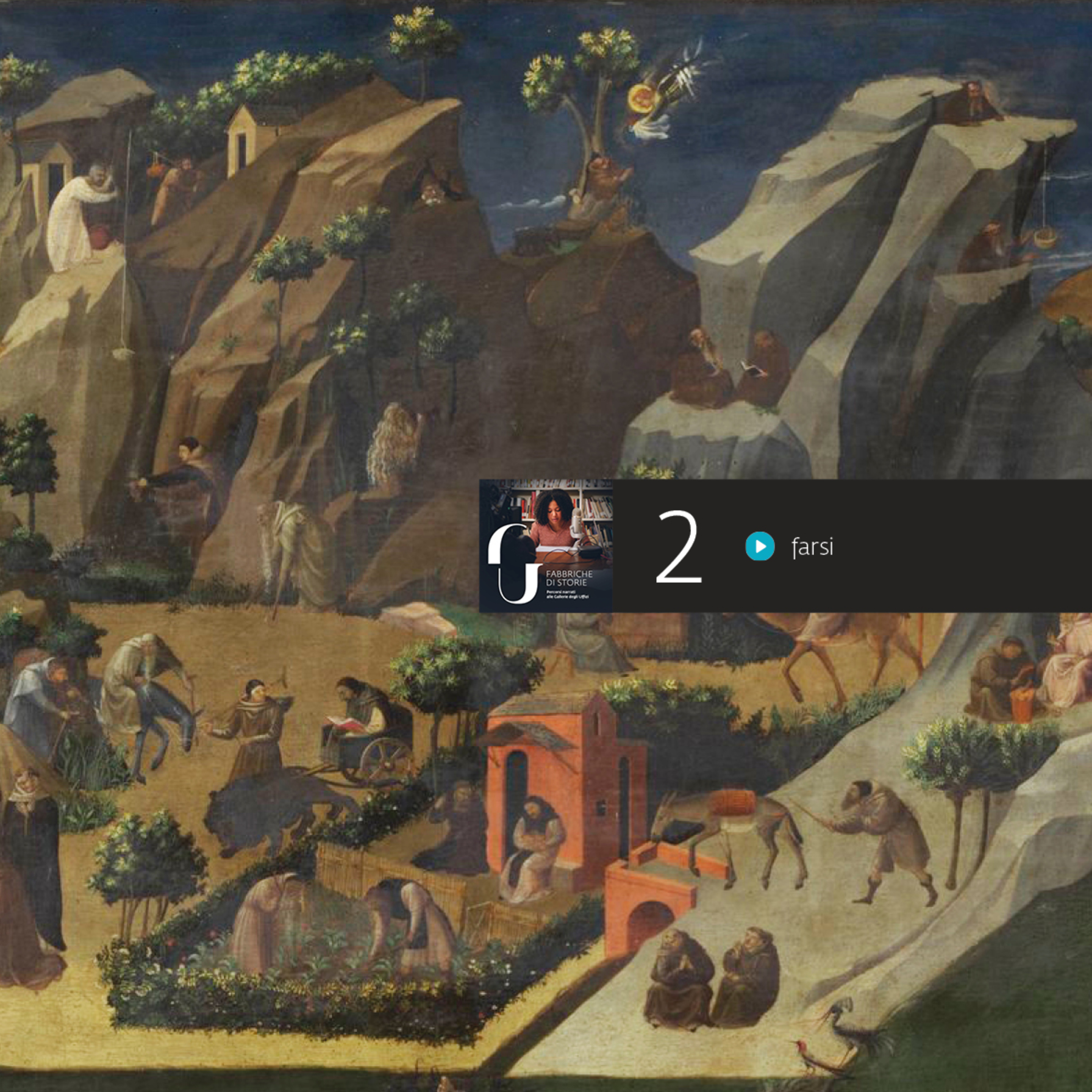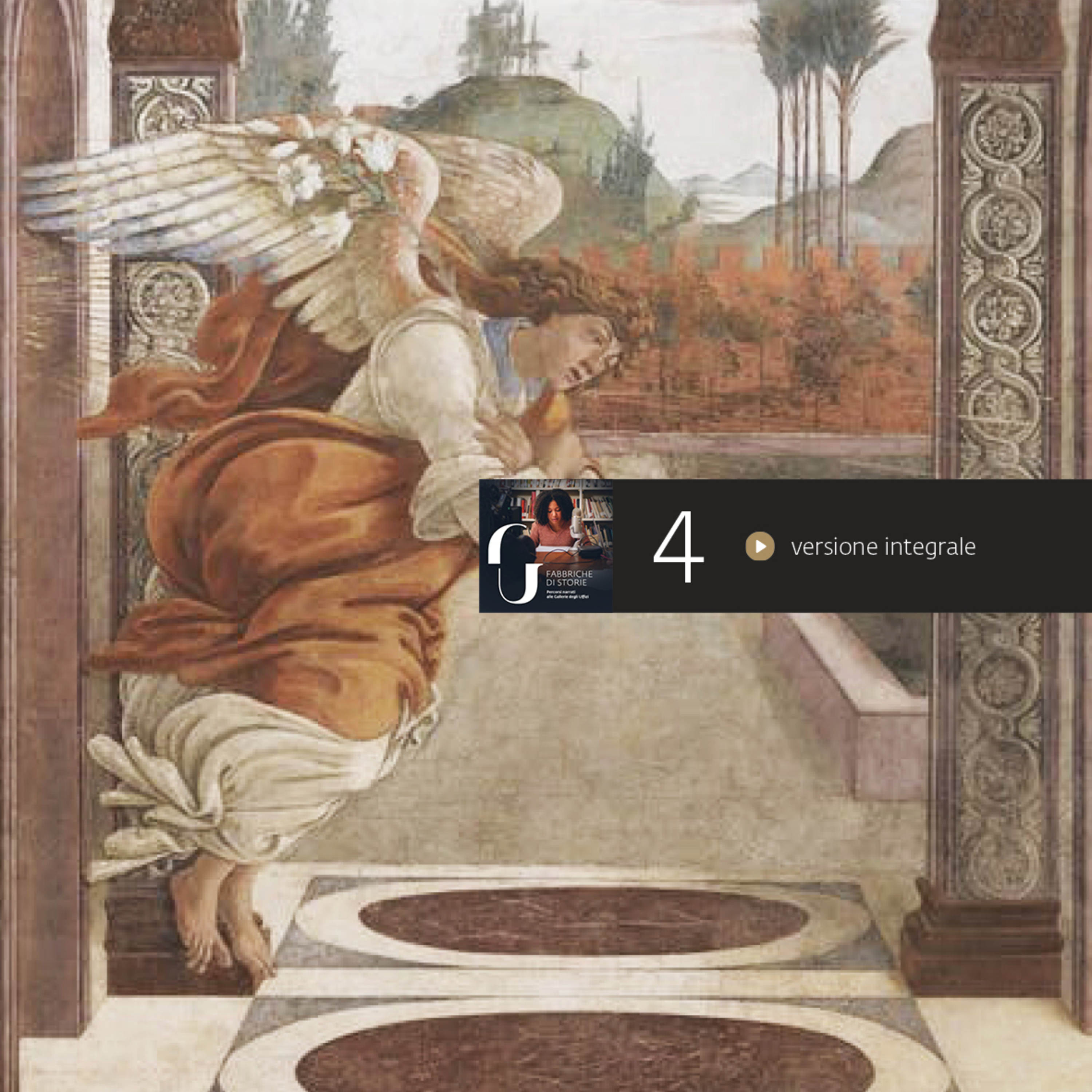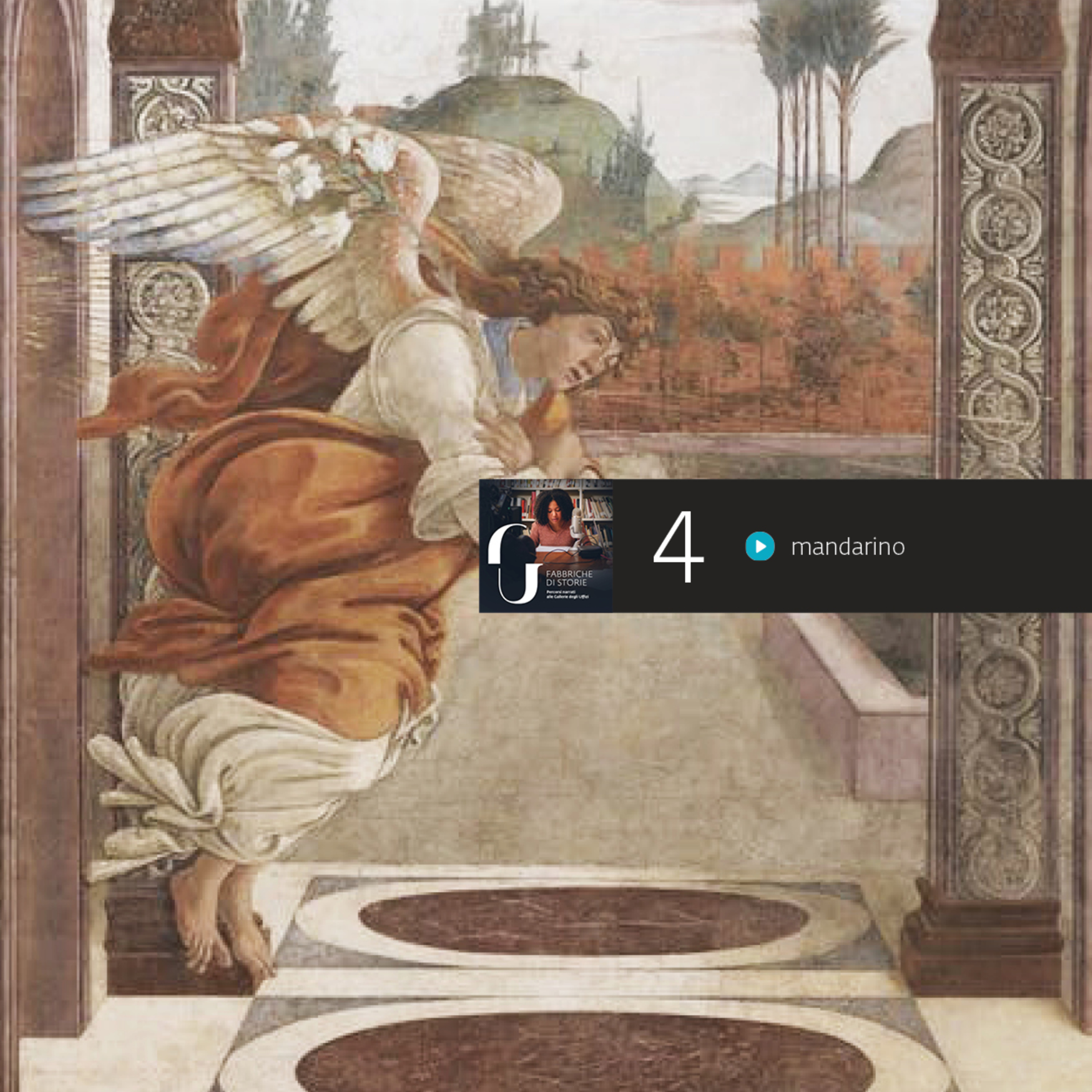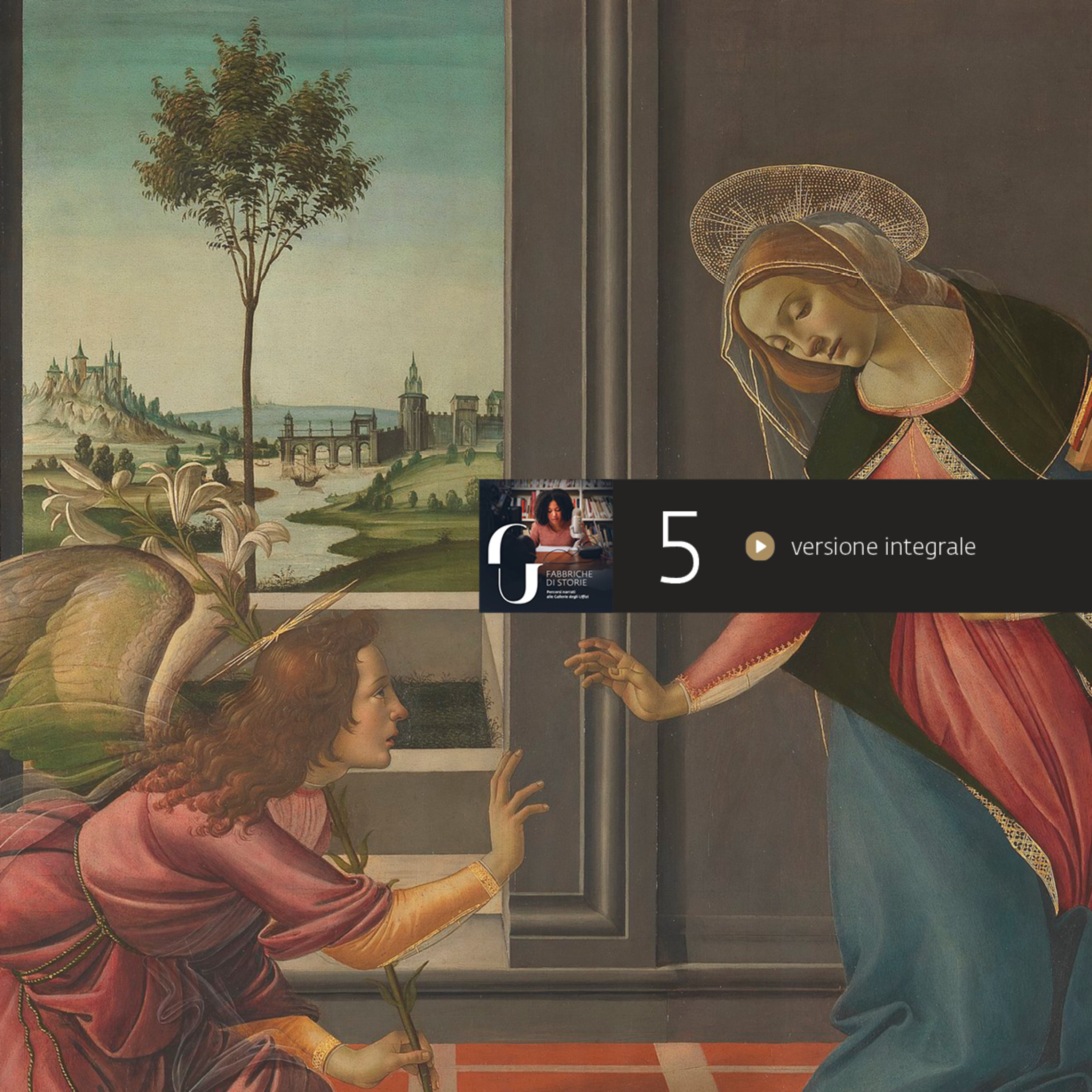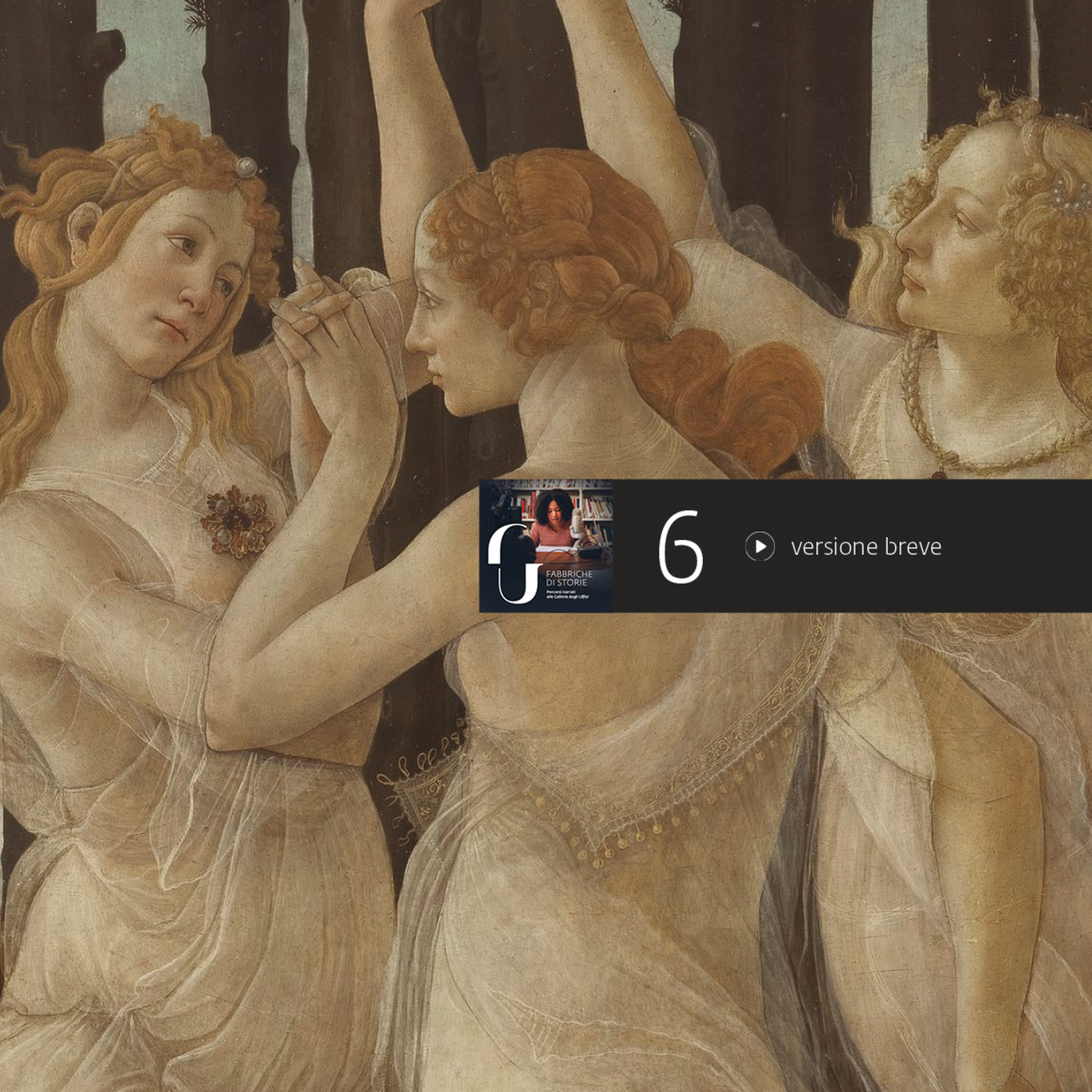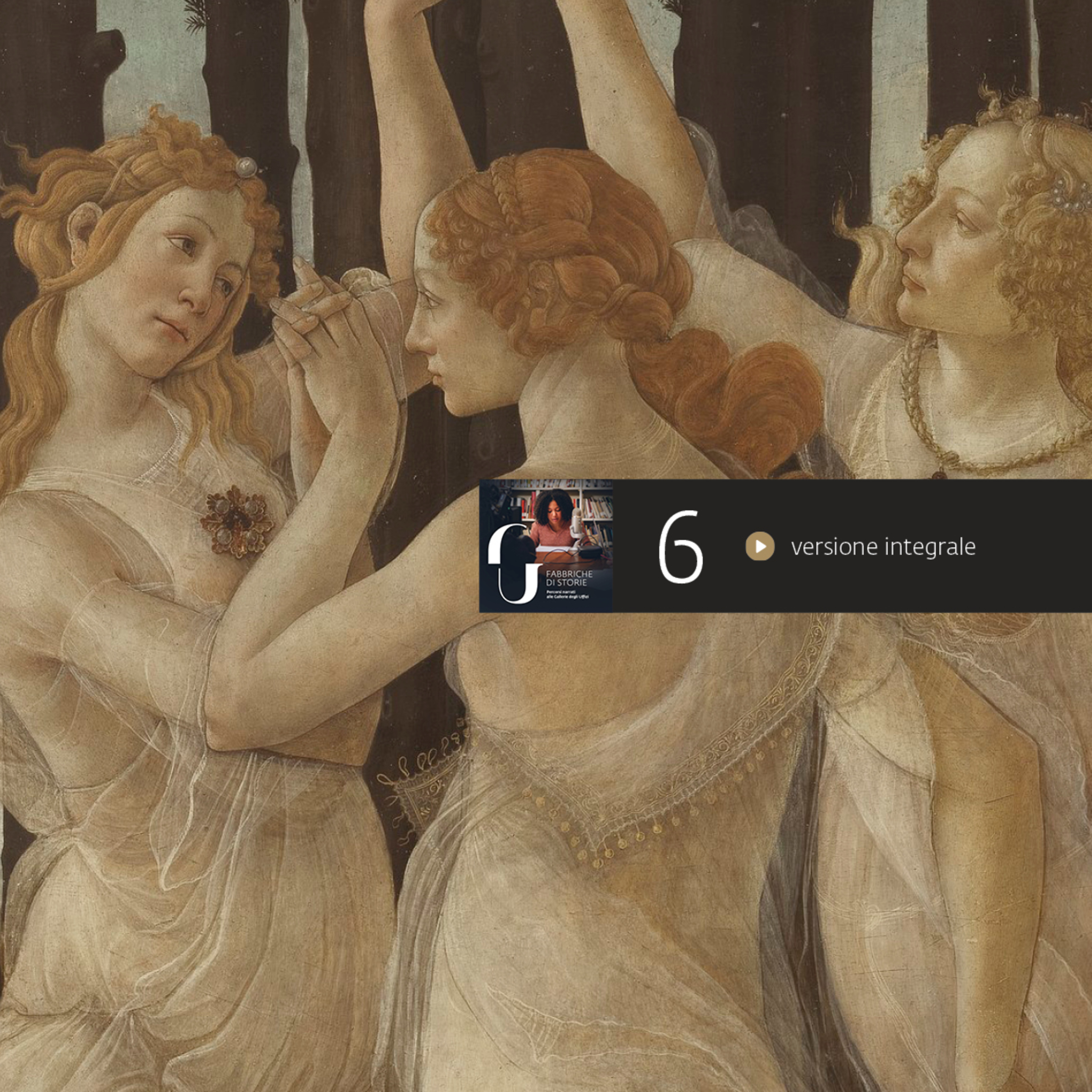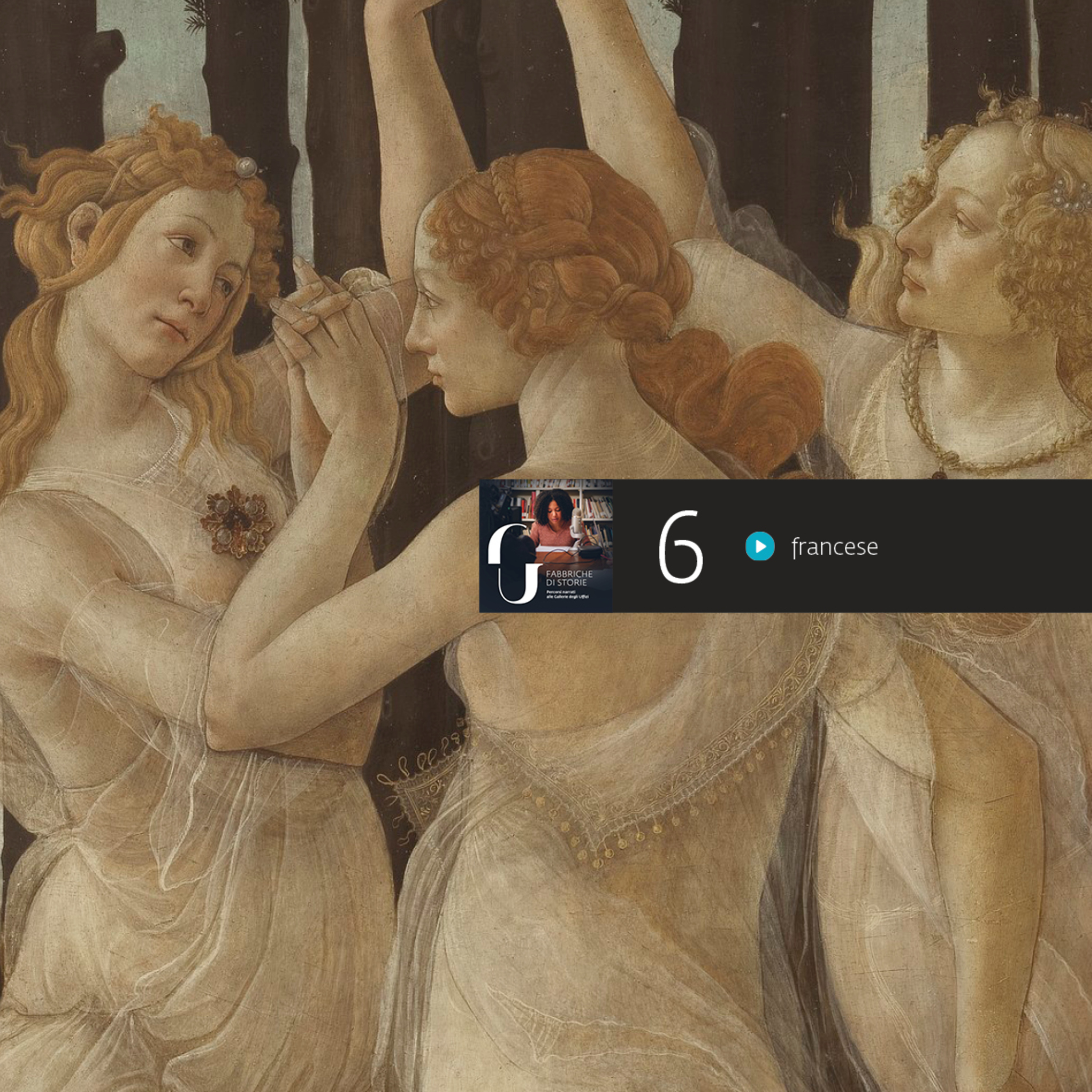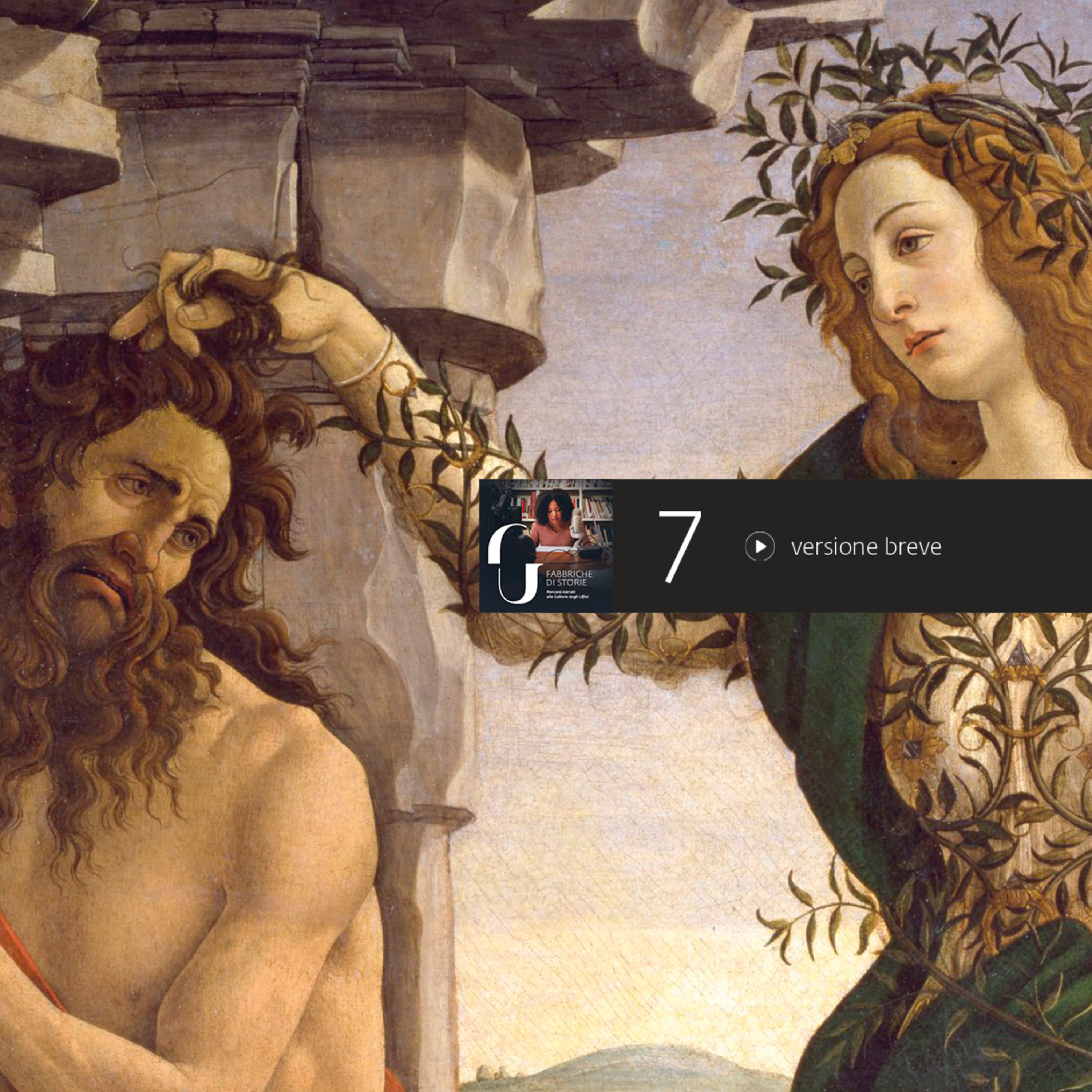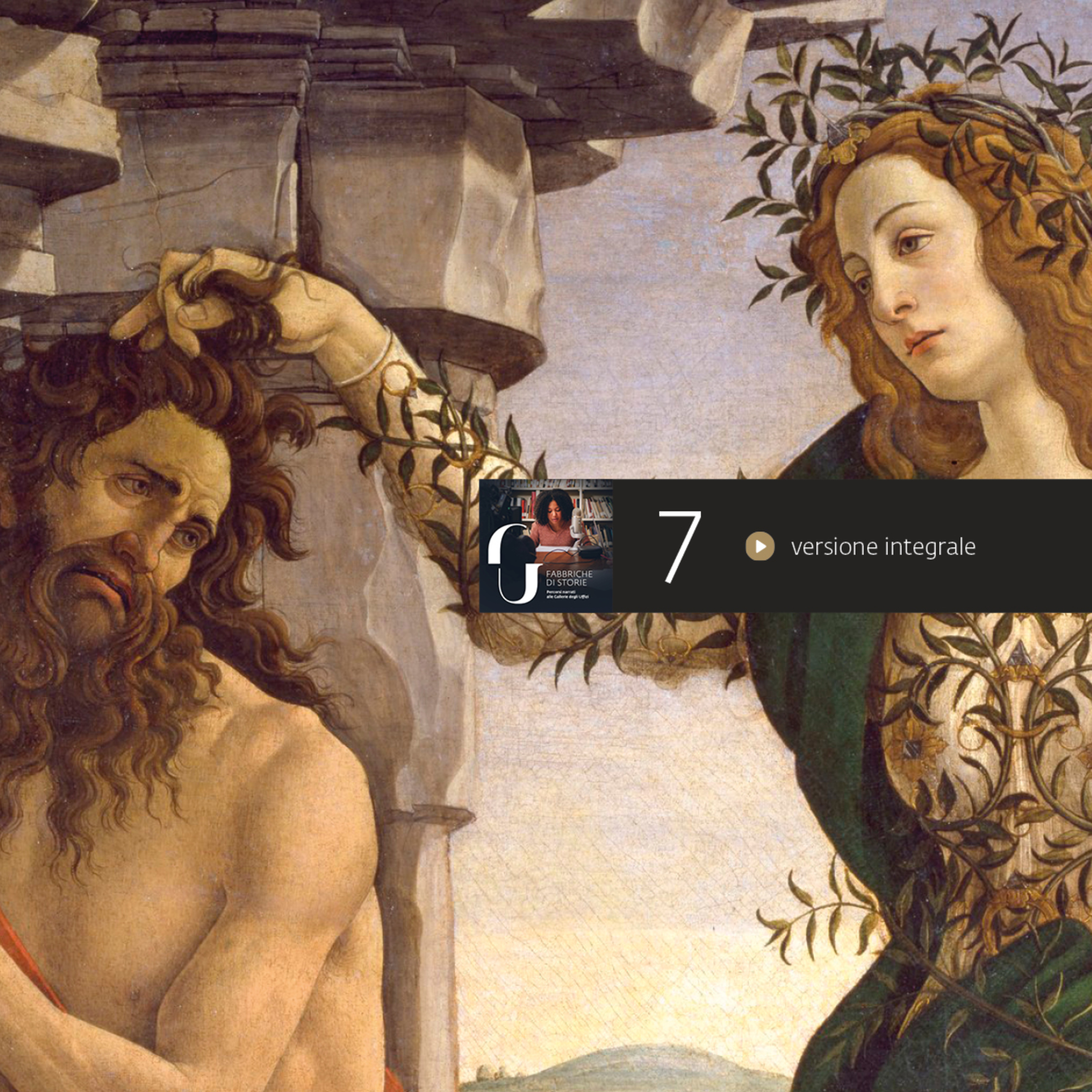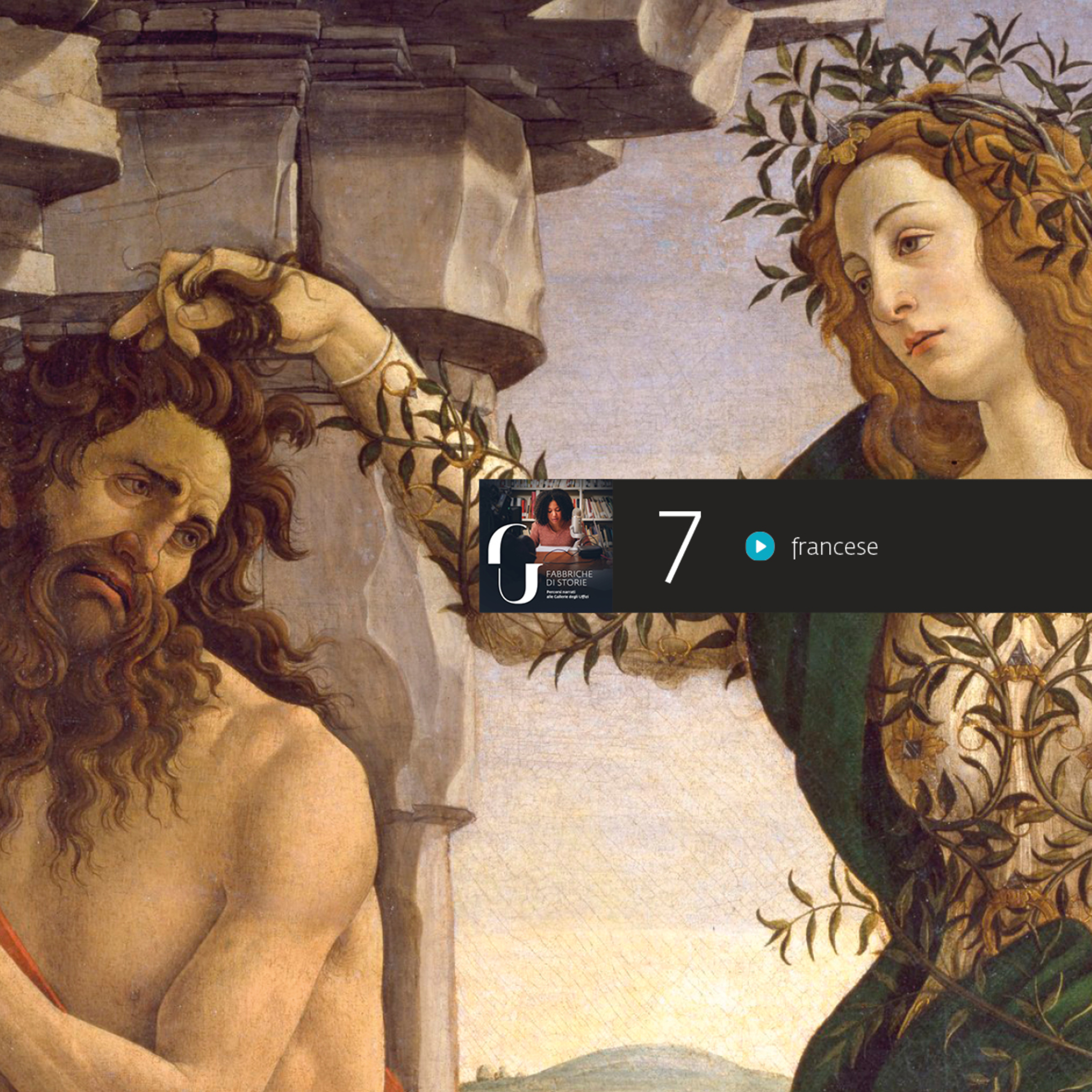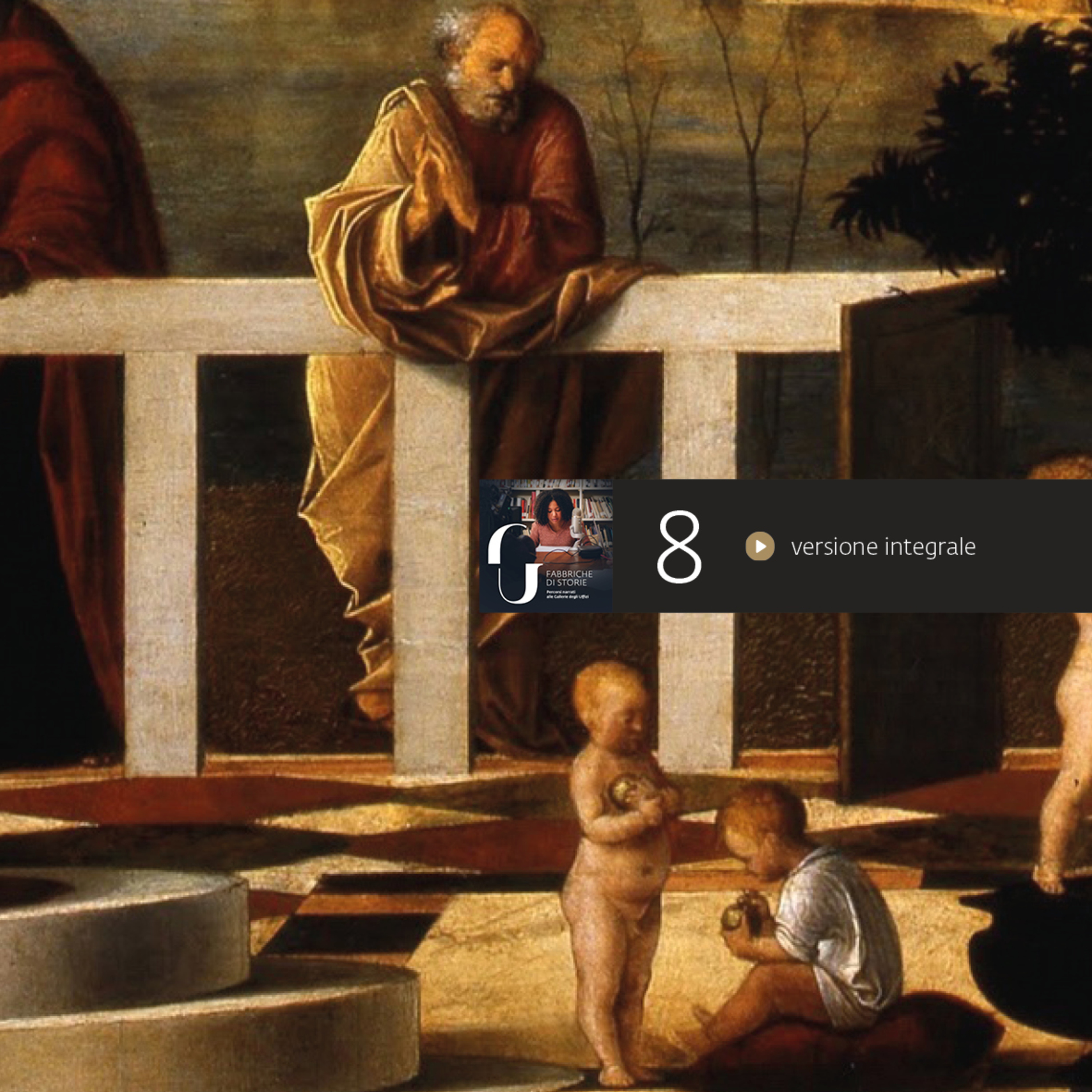Discover Uffizi | Fabbriche di Storie
Uffizi | Fabbriche di Storie

Uffizi | Fabbriche di Storie
Author: uffizigalleries
Subscribed: 23Played: 149Subscribe
Share
© uffizigalleries
Description
Fabbriche di Storie è un progetto di valorizzazione delle collezioni degli Uffizi che coinvolge un gruppo di operatori museali e di cittadini stranieri residenti in italia nella creazione di nuovi percorsi, attraverso tracce audio che accompagnano le persone durante la visita al museo.
Le narrazioni, che riguardano 12 opere degli Uffizi, sono disponibili in italiano e nella lingua madre dei narratori. Sono state registrate versioni lunghe e brevi di ogni narrazione.
Il progetto è coordinato dal Dipartimento Mediazione culturale e Accessibilità delle Gallerie degli Uffizi.
Le narrazioni, che riguardano 12 opere degli Uffizi, sono disponibili in italiano e nella lingua madre dei narratori. Sono state registrate versioni lunghe e brevi di ogni narrazione.
Il progetto è coordinato dal Dipartimento Mediazione culturale e Accessibilità delle Gallerie degli Uffizi.
31 Episodes
Reverse
GENTILE DA FABRIANO |
Adorazione dei Magi |
Uffizi, Sala 5-6 |
Versione breve | La narrazione è di Zeinab Kabil, la voce di Laura Curino |
Leggi la scheda completa dell'opera su uffizi.it
Gentile da Fabriano | Adoration of the Magi | Room 5-6
On a journey, following a star. To meet the Child, here in the foreground.
In the three lunettes of the frame, we can follow the procession of the Magi. In the top left, the three wise men are gazing at the star from a mountain peak overlooking the sea. I wonder: is it possible that, in spite of their precious robes, they too felt the bewilderment and uncertainty of the journey? That, in spite of the lavish procession, they felt alone? That, once at their destination, they longed to return home?
The sea breeze accompanied my journey. When I arrived in Italy, everything was new. The homesickness for my birthplace was replaced by the nostalgia for the person I was when I lived there.
In the central lunette, the Magi are crossing an idyllic landscape to enter Jerusalem. I can smell the scent of my land, the embrace of the warm air. The journey of the three wise men has become an exotic hunting trip, with cheetahs sitting on horseback.
In the top right, finally, the Magi enter Bethlehem, then continue down to where the Child is. The star, almost close enough to touch, now shines above Joseph’s head. The three wise men from the East are represented as the three ages of man. During different stages of their lives, they have all been able to face their challenges.
For them, as for me, travel was a source of knowledge and renewal. When I became an Italian citizen, I started to visit Europe with my children. These journeys were so different from the one that brought me to Italy many years ago. Today I am no longer afraid.
Gentile da Fabriano, the artist who painted this precious panel, travelled a lot too. When he reached Florence he found a new way to make art, which he embraced with an open mind, although he remained faithful to his late-Gothic artistic roots. Thus, for example, he enjoys playing with illusions of depth, but at the same time he maintains as main points of view as there are episodes narrated in the painting.
Opening up to new things while remaining true to ourselves is what I have done with my three children. As they grew up, they enjoyed the freedom of this country, but also the solid nature of their roots. In our house, we wake at dawn, and each one of us pray in silence. In the Koran, there is a verse that says: “My Lord, increase me in knowledge”. In my early days in Italy, prayer was not enough to soothe my worries. Knowledge led me to pray in a way that was more mature, aware.
And it is talking about prayer that I perceive the great unity in this painting, given by the prevalence of gold. This was probably at the request of Palla Strozzi, the rich Florentine banker who commissioned this panel and is depicted behind the youngest of the Magi.
On a symbolic level, however, gold refers to divine light and defines a holy space, bringing harmony even where there is diversity. True wealth does not lie in the material value of gold, but in faith, in knowledge and in the journey.
The Magi went home “by another way” because their lives had changed. My life also changed, and today I am surprised to see, in the center of the predella, these small figures fleeing to safety, towards my land, Egypt.
GENTILE DA FABRIANO |
Adorazione dei Magi |
Uffizi, Sala 5-6 |
Versione integrale | La narrazione è di Zeinab Kabil, la voce di Laura Curino |
Leggi la scheda completa dell'opera su uffizi.it
Gentile da Fabriano | Adoration of the Magi | Room 5-6
On a journey, following a star. To meet the Child, here in the foreground.
In the three lunettes of the frame, we can follow the procession of the Magi. In the top left, the three wise men are gazing at the star from a mountain peak overlooking the sea. I wonder: is it possible that, in spite of their precious robes, they too felt the bewilderment and uncertainty of the journey? That, in spite of the lavish procession, they felt alone? That, once at their destination, they longed to return home?
The sea breeze accompanied my journey. When I arrived in Italy, everything was new. The homesickness for my birthplace was replaced by the nostalgia for the person I was when I lived there.
In the central lunette, the Magi are crossing an idyllic landscape to enter Jerusalem. I can smell the scent of my land, the embrace of the warm air. The journey of the three wise men has become an exotic hunting trip, with cheetahs sitting on horseback.
In the top right, finally, the Magi enter Bethlehem, then continue down to where the Child is. The star, almost close enough to touch, now shines above Joseph’s head. The three wise men from the East are represented as the three ages of man. During different stages of their lives, they have all been able to face their challenges.
For them, as for me, travel was a source of knowledge and renewal. When I became an Italian citizen, I started to visit Europe with my children. These journeys were so different from the one that brought me to Italy many years ago. Today I am no longer afraid.
Gentile da Fabriano, the artist who painted this precious panel, travelled a lot too. When he reached Florence he found a new way to make art, which he embraced with an open mind, although he remained faithful to his late-Gothic artistic roots. Thus, for example, he enjoys playing with illusions of depth, but at the same time he maintains as main points of view as there are episodes narrated in the painting.
Opening up to new things while remaining true to ourselves is what I have done with my three children. As they grew up, they enjoyed the freedom of this country, but also the solid nature of their roots. In our house, we wake at dawn, and each one of us pray in silence. In the Koran, there is a verse that says: “My Lord, increase me in knowledge”. In my early days in Italy, prayer was not enough to soothe my worries. Knowledge led me to pray in a way that was more mature, aware.
And it is talking about prayer that I perceive the great unity in this painting, given by the prevalence of gold. This was probably at the request of Palla Strozzi, the rich Florentine banker who commissioned this panel and is depicted behind the youngest of the Magi.
On a symbolic level, however, gold refers to divine light and defines a holy space, bringing harmony even where there is diversity. True wealth does not lie in the material value of gold, but in faith, in knowledge and in the journey.
The Magi went home “by another way” because their lives had changed. My life also changed, and today I am surprised to see, in the center of the predella, these small figures fleeing to safety, towards my land, Egypt.
GENTILE DA FABRIANO |
Adorazione dei Magi |
Uffizi, Sala 5-6 |
Lingua originale (Arabo) | La narrazione e la voce sono di Zeinab Kabil |
Leggi la scheda completa dell'opera su uffizi.it
Gentile da Fabriano | Adoration of the Magi | Room 5-6
On a journey, following a star. To meet the Child, here in the foreground.
In the three lunettes of the frame, we can follow the procession of the Magi. In the top left, the three wise men are gazing at the star from a mountain peak overlooking the sea. I wonder: is it possible that, in spite of their precious robes, they too felt the bewilderment and uncertainty of the journey? That, in spite of the lavish procession, they felt alone? That, once at their destination, they longed to return home?
The sea breeze accompanied my journey. When I arrived in Italy, everything was new. The homesickness for my birthplace was replaced by the nostalgia for the person I was when I lived there.
In the central lunette, the Magi are crossing an idyllic landscape to enter Jerusalem. I can smell the scent of my land, the embrace of the warm air. The journey of the three wise men has become an exotic hunting trip, with cheetahs sitting on horseback.
In the top right, finally, the Magi enter Bethlehem, then continue down to where the Child is. The star, almost close enough to touch, now shines above Joseph’s head. The three wise men from the East are represented as the three ages of man. During different stages of their lives, they have all been able to face their challenges.
For them, as for me, travel was a source of knowledge and renewal. When I became an Italian citizen, I started to visit Europe with my children. These journeys were so different from the one that brought me to Italy many years ago. Today I am no longer afraid.
Gentile da Fabriano, the artist who painted this precious panel, travelled a lot too. When he reached Florence he found a new way to make art, which he embraced with an open mind, although he remained faithful to his late-Gothic artistic roots. Thus, for example, he enjoys playing with illusions of depth, but at the same time he maintains as main points of view as there are episodes narrated in the painting.
Opening up to new things while remaining true to ourselves is what I have done with my three children. As they grew up, they enjoyed the freedom of this country, but also the solid nature of their roots. In our house, we wake at dawn, and each one of us pray in silence. In the Koran, there is a verse that says: “My Lord, increase me in knowledge”. In my early days in Italy, prayer was not enough to soothe my worries. Knowledge led me to pray in a way that was more mature, aware.
And it is talking about prayer that I perceive the great unity in this painting, given by the prevalence of gold. This was probably at the request of Palla Strozzi, the rich Florentine banker who commissioned this panel and is depicted behind the youngest of the Magi.
On a symbolic level, however, gold refers to divine light and defines a holy space, bringing harmony even where there is diversity. True wealth does not lie in the material value of gold, but in faith, in knowledge and in the journey.
The Magi went home “by another way” because their lives had changed. My life also changed, and today I am surprised to see, in the center of the predella, these small figures fleeing to safety, towards my land, Egypt.
BEATO ANGELICO (attr.) |
Tebaide |
Uffizi, Sala 7 |
Versione breve | La narrazione è di Mohammad Aletaha, la voce di Marco Paolini |
Leggi la scheda completa dell'opera su uffizi.it
Fra Angelico (attr.) | Thebaid | Room 7
In this painting, no one is alone.
This is what struck me when I first approached the Thebaid: it should be a wasteland (the desert near Thebes, Egypt), yet it is a garden; it should be a place of solitude, yet it is filled with relationships. As Athanasius, Bishop of Alexandria, wrote, the desert had become “a city”.
Mashhad is the name of an Iranian holy city; here, an imposing mausoleum was built in the name of the Imam Reza. A once small village was transformed into the most important destination for pilgrims in my country, and a sanctuary built around the mausoleum, creating a city within the city. The heart of the sanctuary is always full of people, even late at night. Many stories can be heard here. Relationships are formed, even among strangers. But when the people pray, personal silence descends.
I think this painting reflects the two extremes of life: there is a space for silence and one for relationships. It is up to us to find a balance. The disorderly scene before us is only apparently so. Most episodes are taken from a collection of hagiographic texts, the Lives of the Desert Fathers, whose increasing spread through Italy determined the success of the Thebaid scenes. This success, however, was ephemeral: the Thebaids we know today, ten in total, were mainly painted in Florence over a period of just fifty years, starting in the early 15th century. Then they disappeared as suddenly as they had appeared. But this was just the beginning of their journey through time: the Thebaids, more often painted on panels rather than frescoed, were uprooted from their context, at times cut and disassembled.
My friends and I were also split up. We used to go to the mountains together. In winter, we would proceed in single file, so that whoever was in front would leave footprints for the others to follow. Outside the refuge, at sunset, we would all be in a circle, laughing and eating, enjoying the natural surroundings and being together. With the Revolution and the war with Iraq, we all left or fled; all except one. For years, we lost sight of one another. Then, when each of us was settled, we were able to get back in touch. It is great to get together, like the reassembled fragments of a painting.
Frescoed Thebaid scenes, seen by many, had a narrative purpose. Those on panels, seen by few, were a support for meditation. They were probably placed in the chapter house of monastic communities, where the Lives of the Fathers would be read aloud in the evening, and then visualized by each monk in the silence of his cell.
I like to think that these monks lived through something similar to what I feel when I am fasting for Ramadan. It is a purification that trains the brain and the heart, suspends hunger and thirst. As a child, my father would take me to the mosque and we would pray with the others. Then preaching became too intolerant. I don’t like those who believe they possess the truth. For many years now, I have been praying alone.
In the Thebaid, monks have their own cell or cave, but they live together in prayer. The relationships between them are full of gestures of care. No one is in command. No one feels superior to the others.
BEATO ANGELICO (attr.) |
Tebaide |
Uffizi, Sala 7 |
Versione integrale | La narrazione è di Mohammad Aletaha, la voce di Marco Paolini |
Leggi la scheda completa dell'opera su uffizi.it
Fra Angelico (attr.) | Thebaid | Room 7
In this painting, no one is alone.
This is what struck me when I first approached the Thebaid: it should be a wasteland (the desert near Thebes, Egypt), yet it is a garden; it should be a place of solitude, yet it is filled with relationships. As Athanasius, Bishop of Alexandria, wrote, the desert had become “a city”.
Mashhad is the name of an Iranian holy city; here, an imposing mausoleum was built in the name of the Imam Reza. A once small village was transformed into the most important destination for pilgrims in my country, and a sanctuary built around the mausoleum, creating a city within the city. The heart of the sanctuary is always full of people, even late at night. Many stories can be heard here. Relationships are formed, even among strangers. But when the people pray, personal silence descends.
I think this painting reflects the two extremes of life: there is a space for silence and one for relationships. It is up to us to find a balance. The disorderly scene before us is only apparently so. Most episodes are taken from a collection of hagiographic texts, the Lives of the Desert Fathers, whose increasing spread through Italy determined the success of the Thebaid scenes. This success, however, was ephemeral: the Thebaids we know today, ten in total, were mainly painted in Florence over a period of just fifty years, starting in the early 15th century. Then they disappeared as suddenly as they had appeared. But this was just the beginning of their journey through time: the Thebaids, more often painted on panels rather than frescoed, were uprooted from their context, at times cut and disassembled.
My friends and I were also split up. We used to go to the mountains together. In winter, we would proceed in single file, so that whoever was in front would leave footprints for the others to follow. Outside the refuge, at sunset, we would all be in a circle, laughing and eating, enjoying the natural surroundings and being together. With the Revolution and the war with Iraq, we all left or fled; all except one. For years, we lost sight of one another. Then, when each of us was settled, we were able to get back in touch. It is great to get together, like the reassembled fragments of a painting.
Frescoed Thebaid scenes, seen by many, had a narrative purpose. Those on panels, seen by few, were a support for meditation. They were probably placed in the chapter house of monastic communities, where the Lives of the Fathers would be read aloud in the evening, and then visualized by each monk in the silence of his cell.
I like to think that these monks lived through something similar to what I feel when I am fasting for Ramadan. It is a purification that trains the brain and the heart, suspends hunger and thirst. As a child, my father would take me to the mosque and we would pray with the others. Then preaching became too intolerant. I don’t like those who believe they possess the truth. For many years now, I have been praying alone.
In the Thebaid, monks have their own cell or cave, but they live together in prayer. The relationships between them are full of gestures of care. No one is in command. No one feels superior to the others.
BEATO ANGELICO (attr.) |
Tebaide |
Uffizi, Sala 7 |
Lingua originale (Farsi) | La narrazione e la voce sono di Mohammad Aletaha |
Leggi la scheda completa dell'opera su uffizi.it
Fra Angelico (attr.) | Thebaid | Room 7
In this painting, no one is alone.
This is what struck me when I first approached the Thebaid: it should be a wasteland (the desert near Thebes, Egypt), yet it is a garden; it should be a place of solitude, yet it is filled with relationships. As Athanasius, Bishop of Alexandria, wrote, the desert had become “a city”.
Mashhad is the name of an Iranian holy city; here, an imposing mausoleum was built in the name of the Imam Reza. A once small village was transformed into the most important destination for pilgrims in my country, and a sanctuary built around the mausoleum, creating a city within the city. The heart of the sanctuary is always full of people, even late at night. Many stories can be heard here. Relationships are formed, even among strangers. But when the people pray, personal silence descends.
I think this painting reflects the two extremes of life: there is a space for silence and one for relationships. It is up to us to find a balance. The disorderly scene before us is only apparently so. Most episodes are taken from a collection of hagiographic texts, the Lives of the Desert Fathers, whose increasing spread through Italy determined the success of the Thebaid scenes. This success, however, was ephemeral: the Thebaids we know today, ten in total, were mainly painted in Florence over a period of just fifty years, starting in the early 15th century. Then they disappeared as suddenly as they had appeared. But this was just the beginning of their journey through time: the Thebaids, more often painted on panels rather than frescoed, were uprooted from their context, at times cut and disassembled.
My friends and I were also split up. We used to go to the mountains together. In winter, we would proceed in single file, so that whoever was in front would leave footprints for the others to follow. Outside the refuge, at sunset, we would all be in a circle, laughing and eating, enjoying the natural surroundings and being together. With the Revolution and the war with Iraq, we all left or fled; all except one. For years, we lost sight of one another. Then, when each of us was settled, we were able to get back in touch. It is great to get together, like the reassembled fragments of a painting.
Frescoed Thebaid scenes, seen by many, had a narrative purpose. Those on panels, seen by few, were a support for meditation. They were probably placed in the chapter house of monastic communities, where the Lives of the Fathers would be read aloud in the evening, and then visualized by each monk in the silence of his cell.
I like to think that these monks lived through something similar to what I feel when I am fasting for Ramadan. It is a purification that trains the brain and the heart, suspends hunger and thirst. As a child, my father would take me to the mosque and we would pray with the others. Then preaching became too intolerant. I don’t like those who believe they possess the truth. For many years now, I have been praying alone.
In the Thebaid, monks have their own cell or cave, but they live together in prayer. The relationships between them are full of gestures of care. No one is in command. No one feels superior to the others.
MASACCIO E MASOLINO |
Sant'Anna Metterza |
Uffizi, Sala 7 |
Versione breve | La narrazione è di Silvia Barlacchi, la voce di Paola Roscioli |
Leggi la scheda completa dell'opera su uffizi.it
Masaccio and Masolino | Virgin and Child with St. Anne | Room 7
A hand on a shoulder brings comfort, however small, slender and apparently fragile. This dual portrait of motherhood is all inside a vertical line: affection, protection, solidarity, trust, courage, from one to the other, through to the Child on his mother’s lap. This however, is not conveyed in words, but in gestures and presence.
Now, in this room there is a mother holding her child, with another woman to protect and guide her. A look that follows affectionately, and one I know well. I am the mother of two girls but, before that, I was a daughter. Between my mother and myself, the same daily acts of care, but which were and said much more. My mother, behind me, speaking to me as she combed my hair: advice, deep and simple thoughts about things, while my gaze was elsewhere.
Angels move around this apparition, guiding our eyes towards the group in the center, joined together by life. Mary’s dress delicately outlines her body, which still seems to bear the signs of pregnancy. In popular tradition, St Anne is the patron saint of mothers who have recently given birth. Hers is a safe presence behind Mary. In mid-air, her left hand extends above the Child, as if to create a protective space that is easily visible to her eyes.
I am inside a grey room. It is day, but the lighting is artificial. I feel alone and wish there could be a hand to hold on to, to face this moment that will change my life forever. In my head, I can still hear the words of someone suggesting that the hand I was seeking was yours, Emma. There was so much pain, but your little hand brought us both out, into the real light. Like the tiny hand of Jesus, resting gently on his mother’s arm.
Depicted behind Mary, St Anne was also referred to as “metterza”, i.e. placed in the third position in relation to the figures of Mary and Child. The panel was executed by two Florentine masters from the early 15th century: Masolino and Masaccio, two artists with different temperaments, who achieved an extraordinary balance in this painting. A hand on a shoulder means collaboration, interaction. The lives and careers of Masaccio and Masolino are woven together: perhaps the younger relied on the older one, and who knows if Masolino actually extended his protection to him. But the future is in Masaccio’s hands, as Mary’s is in hers, in the small, yet already powerful child she holds on her knee.
Motherhood is a journey with so many conflicting feelings. You would never expect that this tiny, defenseless being could contain the strength to guide you through this new experience, as if he contained all the knowledge of life, renewed every time.
I saw you the first time through a door left open. Before that, you were just a picture, pieces of paper: we filled in so many before we could complete your adoption. You came into the room and you stopped, frightened. Every part of me was filled with emotion. I didn’t know if I could touch you. Then I dried your tears, took your little hands and whispered a song in your own language I had learned especially for our meeting. You looked at me and I picked you up. At last I could hold you, and in that moment our lives were joined and we became a family, Sofia Zhiqun.
MASACCIO E MASOLINO |
Sant'Anna Metterza |
Uffizi, Sala 7 |
Versione integrale | La narrazione è di Silvia Barlacchi, la voce di Paola Roscioli |
Leggi la scheda completa dell'opera su uffizi.it
Masaccio and Masolino | Virgin and Child with St. Anne | Room 7
A hand on a shoulder brings comfort, however small, slender and apparently fragile. This dual portrait of motherhood is all inside a vertical line: affection, protection, solidarity, trust, courage, from one to the other, through to the Child on his mother’s lap. This however, is not conveyed in words, but in gestures and presence.
Now, in this room there is a mother holding her child, with another woman to protect and guide her. A look that follows affectionately, and one I know well. I am the mother of two girls but, before that, I was a daughter. Between my mother and myself, the same daily acts of care, but which were and said much more. My mother, behind me, speaking to me as she combed my hair: advice, deep and simple thoughts about things, while my gaze was elsewhere.
Angels move around this apparition, guiding our eyes towards the group in the center, joined together by life. Mary’s dress delicately outlines her body, which still seems to bear the signs of pregnancy. In popular tradition, St Anne is the patron saint of mothers who have recently given birth. Hers is a safe presence behind Mary. In mid-air, her left hand extends above the Child, as if to create a protective space that is easily visible to her eyes.
I am inside a grey room. It is day, but the lighting is artificial. I feel alone and wish there could be a hand to hold on to, to face this moment that will change my life forever. In my head, I can still hear the words of someone suggesting that the hand I was seeking was yours, Emma. There was so much pain, but your little hand brought us both out, into the real light. Like the tiny hand of Jesus, resting gently on his mother’s arm.
Depicted behind Mary, St Anne was also referred to as “metterza”, i.e. placed in the third position in relation to the figures of Mary and Child. The panel was executed by two Florentine masters from the early 15th century: Masolino and Masaccio, two artists with different temperaments, who achieved an extraordinary balance in this painting. A hand on a shoulder means collaboration, interaction. The lives and careers of Masaccio and Masolino are woven together: perhaps the younger relied on the older one, and who knows if Masolino actually extended his protection to him. But the future is in Masaccio’s hands, as Mary’s is in hers, in the small, yet already powerful child she holds on her knee.
Motherhood is a journey with so many conflicting feelings. You would never expect that this tiny, defenseless being could contain the strength to guide you through this new experience, as if he contained all the knowledge of life, renewed every time.
I saw you the first time through a door left open. Before that, you were just a picture, pieces of paper: we filled in so many before we could complete your adoption. You came into the room and you stopped, frightened. Every part of me was filled with emotion. I didn’t know if I could touch you. Then I dried your tears, took your little hands and whispered a song in your own language I had learned especially for our meeting. You looked at me and I picked you up. At last I could hold you, and in that moment our lives were joined and we became a family, Sofia Zhiqun.
SANDRO BOTTICELLI |
Annunciazione |
Uffizi, Sala 10-14 |
Versione breve | La narrazione è di Diana Kong, la voce di Lucilla Giagnoni |
Leggi la scheda completa dell'opera su uffizi.it
Sandro Botticelli | Annunciation (detached fresco)| Room 10-14
This fresco was painted for the Church of San Martino at the Spedale di Santa Maria della Scala in Florence, where abandoned children were taken in. Right away I think: this is why Mary's arms are empty and she wears a frown. I don't think that in this world there exists a mother who truly wants to leave her child! For sure, there must be an unspeakable reason to do so.
From 1478 to 1479, Florence was struck by a terrible plague; many of the victims were buried in the monastery attached to the church. In 1481, Botticelli was paid for the creation of an Annunciation, probably a votive offering to the Virgin Mary for the end of the epidemic. The background filled with a quiet and beautiful nature could comfort people. The angel could bring them good news. I do not believe it is by chance that the angel's point of view is the one from which to admire the entire scene. The fresco was located in the loggia before the church entrance, right on top of the door, and the angel was seen right in the centre by those who entered.
It was the Annunciation, and not the Spring that struck me when I entered this room. Its light and transparent colors gave me a sense of peace; the wide-open space made me breathe. Mary’s home overlooks this space. It is a rich household. In the shadows of the room there is a very clean and well-made bed, too much so: I would not like to sleep on this bed. What I love is the air that moves through the arches. Natural light filters through the enclosed garden, and beyond, a landscape.
In China I lived with my family in a large apartment, but from our windows we could only see the skyscraper in front of us. It's unpleasant to not have an open view. If I had a house like this, it would be perfect. However, if I were living alone in such a big space, I would not be happy. Just as my parents feel the house is silent since I left.
I look at the Virgin in the fresco. She looks a bit sad and solitary. The canopy, carpet and lectern create a space of her own, where she can feel close to God. Her arms seem to create a space for a child who is not there yet.
An imaginary door has just opened in front of her. A strange wind accompanies the arrival of the angel. His feet have not yet touched the ground. The news he is bringing to Mary travels through the light.
In the space between the angel and Mary, I immediately felt how distant my family is. Every time I travel, I send a postcard to my mother. She collects them all in a box. They are important to create a memory, a story we can share; otherwise, not much would remain of these years spent far away from each other.
The postcards do not always arrive in the order in which I sent them; some get lost, but it is not important. In this world, nothing is perfect.
The angel comes to bring news about me to my family. The angel will then leave, and Mary will be alone again.
The environment where Mary lives is open, full of air. The precious marble patterns of the floor make the scene even dreamier. An ideal world, but one within reach, if only we were able to give ourselves space and time.
This home has no doors. Outside there is no one. In the distance, the poetry of nature. It will soon be dusk.
SANDRO BOTTICELLI |
Annunciazione |
Uffizi, Sala 10-14 |
Lingua originale (Cinese Mandarino) | La narrazione e la voce sono di Diana Kong |
Leggi la scheda completa dell'opera su uffizi.it
Sandro Botticelli | Annunciation (detached fresco)| Room 10-14
This fresco was painted for the Church of San Martino at the Spedale di Santa Maria della Scala in Florence, where abandoned children were taken in. Right away I think: this is why Mary's arms are empty and she wears a frown. I don't think that in this world there exists a mother who truly wants to leave her child! For sure, there must be an unspeakable reason to do so.
From 1478 to 1479, Florence was struck by a terrible plague; many of the victims were buried in the monastery attached to the church. In 1481, Botticelli was paid for the creation of an Annunciation, probably a votive offering to the Virgin Mary for the end of the epidemic. The background filled with a quiet and beautiful nature could comfort people. The angel could bring them good news. I do not believe it is by chance that the angel's point of view is the one from which to admire the entire scene. The fresco was located in the loggia before the church entrance, right on top of the door, and the angel was seen right in the centre by those who entered.
It was the Annunciation, and not the Spring that struck me when I entered this room. Its light and transparent colors gave me a sense of peace; the wide-open space made me breathe. Mary’s home overlooks this space. It is a rich household. In the shadows of the room there is a very clean and well-made bed, too much so: I would not like to sleep on this bed. What I love is the air that moves through the arches. Natural light filters through the enclosed garden, and beyond, a landscape.
In China I lived with my family in a large apartment, but from our windows we could only see the skyscraper in front of us. It's unpleasant to not have an open view. If I had a house like this, it would be perfect. However, if I were living alone in such a big space, I would not be happy. Just as my parents feel the house is silent since I left.
I look at the Virgin in the fresco. She looks a bit sad and solitary. The canopy, carpet and lectern create a space of her own, where she can feel close to God. Her arms seem to create a space for a child who is not there yet.
An imaginary door has just opened in front of her. A strange wind accompanies the arrival of the angel. His feet have not yet touched the ground. The news he is bringing to Mary travels through the light.
In the space between the angel and Mary, I immediately felt how distant my family is. Every time I travel, I send a postcard to my mother. She collects them all in a box. They are important to create a memory, a story we can share; otherwise, not much would remain of these years spent far away from each other.
The postcards do not always arrive in the order in which I sent them; some get lost, but it is not important. In this world, nothing is perfect.
The angel comes to bring news about me to my family. The angel will then leave, and Mary will be alone again.
The environment where Mary lives is open, full of air. The precious marble patterns of the floor make the scene even dreamier. An ideal world, but one within reach, if only we were able to give ourselves space and time.
This home has no doors. Outside there is no one. In the distance, the poetry of nature. It will soon be dusk.
SANDRO BOTTICELLI |
Annunciazione di Cestello e Cristo in Pietà |
Uffizi, Sala 10-14 |
Versione breve | La narrazione è di Fabiana Bianchini, la voce di Maria Paiato |
Leggi la scheda completa dell'opera su uffizi.it
Sandro Botticelli | The Cestello Annunciation and Pietà | Room 10-14
The hands are suspended in space, as if waiting. The angel has just arrived. A puff of wind passes through his light veil. Like conception, like life: a gasp, a breath. He kneels, a hand outstretched towards Mary to reassure her. Distracted from her reading, the Virgin almost turns upon herself; her gaze is turned inwards, as if listening to the heartbeat. One hand says “wait”, the other is level with her heart. It takes time to take in a piece of news. The announcement changes the Virgin: life changes with a child.
The life growing inside you brings immense emotions with it. You are no longer alone; there’s someone living in your womb, the perfect home. When I was expecting my daughter, she lived perfectly inside me and had everything she needed through me. Wait! I’m not ready! Perhaps I am enough for you now, but later, when I am no longer your perfect dwelling place? What will become of us? Wait!
One needs time to understand, to accept. Mary accepts her son, and her pain too, as foreshadowed in the Pietà in the bottom of the frame. It is difficult to accept what can be taken away.
Here, where the angel has just landed, we find ourselves in the shelter of a home. Gabriel, silhouetted against the door, is somehow outside Mary’s domestic space; at the same time, by bursting into the house, he brings God’s breath into a human space.
Mary’s womb contains divine life and breath; it is a perfect home, but with time it will inevitably become too small. Perhaps we are all seeking the perfect home, but all the places where we live push us out at some point.
Behind the angel there is a door, with glimpses of a walled garden – a reference to Mary’s purity – and a magnificent view. Botticelli has painted a young tree in the middle. Some experts think it is an ash: a Marian plant, lethal to snakes like the Virgin is lethal to the devil. Other academics see it as an oak. I like to think it is. Its roots can emerge from the soil and re-enter it in more distant places, drawing ever more strength.
Botticelli painted this Annunciation during a religious crisis triggered by the preaching in Florence of Girolamo Savonarola, the Dominican friar who played a leading role in establishing the Republic in 1494. His sermons profoundly affected the artist who for years had been the leading exponent of the neo-Platonic culture promoted by the Medici family. Here, in this austere space, the figures of Mary and the angel are animated by a spiritual tension not found in Botticelli’s previous work.
The painting, which had originally been painted for the Church of Cestello, arrived in the Uffizi in 1872.
That same Gallery is where I began to work as a museum guard in 1986. But I didn’t look at the artworks; I was too much in pain. I really became aware of the Cestello Annunciation when I was asked to choose a painting. I felt something in those hands, which Mary holds as if protecting her heart. The baby’s heart, the first thing detected in a scan. It’s the only thing you see, a breath, a beat... That is why I chose this painting, or it chose me, because after all, it is artworks that reflect our emotions, they resemble us, and call on us to weave our stories with theirs.
SANDRO BOTTICELLI |
Annunciazione di Cestello e Cristo in Pietà |
Uffizi, Sala 10-14 |
Versione integrale | La narrazione è di Fabiana Bianchini, la voce di Maria Paiato |
Leggi la scheda completa dell'opera su uffizi.it
Sandro Botticelli | The Cestello Annunciation and Pietà | Room 10-14
The hands are suspended in space, as if waiting. The angel has just arrived. A puff of wind passes through his light veil. Like conception, like life: a gasp, a breath. He kneels, a hand outstretched towards Mary to reassure her. Distracted from her reading, the Virgin almost turns upon herself; her gaze is turned inwards, as if listening to the heartbeat. One hand says “wait”, the other is level with her heart. It takes time to take in a piece of news. The announcement changes the Virgin: life changes with a child.
The life growing inside you brings immense emotions with it. You are no longer alone; there’s someone living in your womb, the perfect home. When I was expecting my daughter, she lived perfectly inside me and had everything she needed through me. Wait! I’m not ready! Perhaps I am enough for you now, but later, when I am no longer your perfect dwelling place? What will become of us? Wait!
One needs time to understand, to accept. Mary accepts her son, and her pain too, as foreshadowed in the Pietà in the bottom of the frame. It is difficult to accept what can be taken away.
Here, where the angel has just landed, we find ourselves in the shelter of a home. Gabriel, silhouetted against the door, is somehow outside Mary’s domestic space; at the same time, by bursting into the house, he brings God’s breath into a human space.
Mary’s womb contains divine life and breath; it is a perfect home, but with time it will inevitably become too small. Perhaps we are all seeking the perfect home, but all the places where we live push us out at some point.
Behind the angel there is a door, with glimpses of a walled garden – a reference to Mary’s purity – and a magnificent view. Botticelli has painted a young tree in the middle. Some experts think it is an ash: a Marian plant, lethal to snakes like the Virgin is lethal to the devil. Other academics see it as an oak. I like to think it is. Its roots can emerge from the soil and re-enter it in more distant places, drawing ever more strength.
Botticelli painted this Annunciation during a religious crisis triggered by the preaching in Florence of Girolamo Savonarola, the Dominican friar who played a leading role in establishing the Republic in 1494. His sermons profoundly affected the artist who for years had been the leading exponent of the neo-Platonic culture promoted by the Medici family. Here, in this austere space, the figures of Mary and the angel are animated by a spiritual tension not found in Botticelli’s previous work.
The painting, which had originally been painted for the Church of Cestello, arrived in the Uffizi in 1872.
That same Gallery is where I began to work as a museum guard in 1986. But I didn’t look at the artworks; I was too much in pain. I really became aware of the Cestello Annunciation when I was asked to choose a painting. I felt something in those hands, which Mary holds as if protecting her heart. The baby’s heart, the first thing detected in a scan. It’s the only thing you see, a breath, a beat... That is why I chose this painting, or it chose me, because after all, it is artworks that reflect our emotions, they resemble us, and call on us to weave our stories with theirs.
SANDRO BOTTICELLI |
Primavera |
Uffizi, Sala 10-14 |
Versione breve | La narrazione è di Kuassi Sessou, la voce di Marco Baliani |
Leggi la scheda completa dell'opera su uffizi.it
Sandro Botticelli | Spring | Room 10-14
This garden is like paradise. An earthly paradise where everything had meaning, before the arrival of man.
I tried to imagine this meadow empty. The variety of flowers is immense. Everything is perfect, unspoiled. Every detail contributes to the whole. In my eyes, all this takes on an extraordinary affinity with African spirituality: at its center is Nature as a divinity that may be found in the trees, the river, the sun, the wind. That same wind that here, in the Spring by Botticelli, puffs out the clothes, fertilizes the plants, a breath of life that permeates everything. The Spring is a masterpiece of profane art, yet I find it has a strong religious dimension.
I start to move across the meadow. The slender trunks of the orange trees slowly become more imposing as I enter, creating darkness around me, taking me back to my childhood: it’s four in the morning, my uncle is holding the hand of my brother, who needs care; he starts to speak in a language I don’t know, because the ritual needs words other than everyday language. Not everyone enters the sacred woods. That wood is a place that needs utmost silence and respect, because it’s where one goes to meet the gods, to speak with plants.
This wood, too, is a sacred space, ready to welcome divine presences. A gust of wind and Zephyr bursts onto the scene. With his breath of life, he fertilizes the nymph Cloris, who is transformed into Flora. Venus, the goddess of love and fertility, appears in the center. Above her, Cupid is ready to fire off his arrow. The wave-like movement continues with the Three Graces and ends with Mercury, chasing off the clouds that threaten the end of spring.
Although the mythological characters are easy to identify, the meaning of their meeting has given rise to countless interpretations. Many are linked to the Medici, who commissioned the Spring. Some scholars see it as a political celebration of Florence flourishing under their rule. On a philosophical level, the painting shows the journey to perfection of the soul, also alluding to the Medici, patrons of the neo-platonic Academy: Zephyr is the sensual power of love; thanks to the mediation of Venus, it is transformed into a higher form, the love that is given, represented by the Three Graces; finally, Mercury aims for supreme perfection, that of the heavens.
My gaze returns to the meadow, to the feet of these three ethereal girls dancing. It is such a perfect dance as to seem completed. Yet this is the point of the painting that invites me to enter. I would enter in small steps, like I did as a child. Suddenly, you find yourself inside the circle. You start doing what the others do, and become part of that circle. The dance, held once a year, followed a precise ritual: to implore gods, chase out sickness and bring health, but also to explain the roundness of the earth, the central position of human beings. Different gestures and contexts, but is it so distant from the man lord of all things celebrated in 15th century-Florence?
It is not possible to remain in the sacred woods, the woods of Venus, but whatever is learned there can be taken with you. And it is a shame for those who did not know how to walk through it.
SANDRO BOTTICELLI |
Primavera |
Uffizi, Sala 10-14 |
Versione integrale | La narrazione è di Kuassi Sessou, la voce di Marco Baliani|
Leggi la scheda completa dell'opera su uffizi.it
Sandro Botticelli | Spring | Room 10-14
This garden is like paradise. An earthly paradise where everything had meaning, before the arrival of man.
I tried to imagine this meadow empty. The variety of flowers is immense. Everything is perfect, unspoiled. Every detail contributes to the whole. In my eyes, all this takes on an extraordinary affinity with African spirituality: at its center is Nature as a divinity that may be found in the trees, the river, the sun, the wind. That same wind that here, in the Spring by Botticelli, puffs out the clothes, fertilizes the plants, a breath of life that permeates everything. The Spring is a masterpiece of profane art, yet I find it has a strong religious dimension.
I start to move across the meadow. The slender trunks of the orange trees slowly become more imposing as I enter, creating darkness around me, taking me back to my childhood: it’s four in the morning, my uncle is holding the hand of my brother, who needs care; he starts to speak in a language I don’t know, because the ritual needs words other than everyday language. Not everyone enters the sacred woods. That wood is a place that needs utmost silence and respect, because it’s where one goes to meet the gods, to speak with plants.
This wood, too, is a sacred space, ready to welcome divine presences. A gust of wind and Zephyr bursts onto the scene. With his breath of life, he fertilizes the nymph Cloris, who is transformed into Flora. Venus, the goddess of love and fertility, appears in the center. Above her, Cupid is ready to fire off his arrow. The wave-like movement continues with the Three Graces and ends with Mercury, chasing off the clouds that threaten the end of spring.
Although the mythological characters are easy to identify, the meaning of their meeting has given rise to countless interpretations. Many are linked to the Medici, who commissioned the Spring. Some scholars see it as a political celebration of Florence flourishing under their rule. On a philosophical level, the painting shows the journey to perfection of the soul, also alluding to the Medici, patrons of the neo-platonic Academy: Zephyr is the sensual power of love; thanks to the mediation of Venus, it is transformed into a higher form, the love that is given, represented by the Three Graces; finally, Mercury aims for supreme perfection, that of the heavens.
My gaze returns to the meadow, to the feet of these three ethereal girls dancing. It is such a perfect dance as to seem completed. Yet this is the point of the painting that invites me to enter. I would enter in small steps, like I did as a child. Suddenly, you find yourself inside the circle. You start doing what the others do, and become part of that circle. The dance, held once a year, followed a precise ritual: to implore gods, chase out sickness and bring health, but also to explain the roundness of the earth, the central position of human beings. Different gestures and contexts, but is it so distant from the man lord of all things celebrated in 15th century-Florence?
It is not possible to remain in the sacred woods, the woods of Venus, but whatever is learned there can be taken with you. And it is a shame for those who did not know how to walk through it.
SANDRO BOTTICELLI |
Primavera |
Uffizi, Sala 10-14 |
Lingua originale (Francese) | La narrazione e la voce sono di Kuassi Sessou |
Leggi la scheda completa dell'opera su uffizi.it
Sandro Botticelli | Spring | Room 10-14
This garden is like paradise. An earthly paradise where everything had meaning, before the arrival of man.
I tried to imagine this meadow empty. The variety of flowers is immense. Everything is perfect, unspoiled. Every detail contributes to the whole. In my eyes, all this takes on an extraordinary affinity with African spirituality: at its center is Nature as a divinity that may be found in the trees, the river, the sun, the wind. That same wind that here, in the Spring by Botticelli, puffs out the clothes, fertilizes the plants, a breath of life that permeates everything. The Spring is a masterpiece of profane art, yet I find it has a strong religious dimension.
I start to move across the meadow. The slender trunks of the orange trees slowly become more imposing as I enter, creating darkness around me, taking me back to my childhood: it’s four in the morning, my uncle is holding the hand of my brother, who needs care; he starts to speak in a language I don’t know, because the ritual needs words other than everyday language. Not everyone enters the sacred woods. That wood is a place that needs utmost silence and respect, because it’s where one goes to meet the gods, to speak with plants.
This wood, too, is a sacred space, ready to welcome divine presences. A gust of wind and Zephyr bursts onto the scene. With his breath of life, he fertilizes the nymph Cloris, who is transformed into Flora. Venus, the goddess of love and fertility, appears in the center. Above her, Cupid is ready to fire off his arrow. The wave-like movement continues with the Three Graces and ends with Mercury, chasing off the clouds that threaten the end of spring.
Although the mythological characters are easy to identify, the meaning of their meeting has given rise to countless interpretations. Many are linked to the Medici, who commissioned the Spring. Some scholars see it as a political celebration of Florence flourishing under their rule. On a philosophical level, the painting shows the journey to perfection of the soul, also alluding to the Medici, patrons of the neo-platonic Academy: Zephyr is the sensual power of love; thanks to the mediation of Venus, it is transformed into a higher form, the love that is given, represented by the Three Graces; finally, Mercury aims for supreme perfection, that of the heavens.
My gaze returns to the meadow, to the feet of these three ethereal girls dancing. It is such a perfect dance as to seem completed. Yet this is the point of the painting that invites me to enter. I would enter in small steps, like I did as a child. Suddenly, you find yourself inside the circle. You start doing what the others do, and become part of that circle. The dance, held once a year, followed a precise ritual: to implore gods, chase out sickness and bring health, but also to explain the roundness of the earth, the central position of human beings. Different gestures and contexts, but is it so distant from the man lord of all things celebrated in 15th century-Florence?
It is not possible to remain in the sacred woods, the woods of Venus, but whatever is learned there can be taken with you. And it is a shame for those who did not know how to walk through it.
SANDRO BOTTICELLI |
Pallade e il Centauro |
Uffizi, Sala 10-14 |
Versione breve | La narrazione è di Sofia Kossiwa Sessou, la voce di Lella Costa |
Leggi la scheda completa dell'opera su uffizi.it
Sandro Botticelli | Pallas and the Centaur | Room 10-14
My feet were swinging over the emptiness from the peak where I was sitting, when I heard a rumble from the other side of the hill. The noise became ever more intense when, out of a cloud of dust, I saw the disconnected gallop of a Centaur. He began to skirt the stone wall, but finding no way out, he stopped. The striking of his hooves marked the passage of time towards something inexorable. He kept his eyes fixed on the horizon, forcing me to do the same.
Then I saw her, moving forward slowly, like a cat about to pounce. The wind was creating small silky whirlpools on her clothes. But it was her eyes, pale grey and magnetic, that conveyed her true fascination. Just a few steps from the Centaur, she extended her fingers towards his head, but he withdrew. “Why do you move away, Centaur? Do I disgust you? Or do you fear me?”
“How could you ever disgust me, oh Pallas Athena?” he answered. “I am afraid not of you, but for my freedom. I love to live by my instinct and please my senses beyond all limits, but cannot do so if I am not free of you. So why do you persecute me?”
Athena answered: “There was once a Greek philosopher, Plato was his name. I will now tell you the story he told the world. After death, the soul has a moment of reminiscence in which it appears as a chariot, pulled by two horses – the black one lustful and moving downwards, the white one spiritual and moving upwards – and driven by a charioteer. Mine is not a persecution, Centaur. What you call freedom is the submission of your spirituality to passions. If you accept my guidance, I will be the charioteer who takes you to greatness”. The Centaur silently bowed his head. The goddess took his hair, harnessing it in a soft, yet firm grip, and led him out from the shadow, towards the horizon.
I climbed down the peak and ran, reached the narrow streets of Florence, pushed the door into my master’s workshop and called out loudly: “Mastro Botticelli!” At the end of my story he did not say a word, but raised the white cloth covering a mysterious canvas before which he was sitting, revealing Pallas in the act of seizing the Centaur’s hair. “How is that possible?” I asked, shocked. Botticelli said: “When Lorenzo de’ Medici commissioned a painting to convey the political image of his family, I found myself wandering on that peak, in search of inspiration. The vision of Athena’s triumph over the Centaur answered my doubts: she was the clearest example of a power that brought order back to the Centaur’s soul, just as the Medici brought peace to Florence”.
He suddenly stopped and smiled at me. “What could be so important as to afflict your young mind, to bother that poor Centaur and the divine Athena?” Ignoring his condescending tone, I said: “Sir, for years I have been dragging a ‘beast’ inside me, which nourishes my creativity. I could not be without it: it is my instinctive and emotional soul. But it is out of control. Athena honoured me with her presence, perhaps, because of what I aspire to become: a woman who lives her passions, but is not overwhelmed by them”.
At the end of my passionate monologue, Botticelli looked at me with a touch of melancholy: probably, he knew something about it too.
SANDRO BOTTICELLI |
Pallade e il Centauro |
Uffizi, Sala 10-14 |
Versione integrale | La narrazione è di Sofia Kossiwa Sessou, la voce di Lella Costa |
Leggi la scheda completa dell'opera su uffizi.it
Sandro Botticelli | Pallas and the Centaur | Room 10-14
My feet were swinging over the emptiness from the peak where I was sitting, when I heard a rumble from the other side of the hill. The noise became ever more intense when, out of a cloud of dust, I saw the disconnected gallop of a Centaur. He began to skirt the stone wall, but finding no way out, he stopped. The striking of his hooves marked the passage of time towards something inexorable. He kept his eyes fixed on the horizon, forcing me to do the same.
Then I saw her, moving forward slowly, like a cat about to pounce. The wind was creating small silky whirlpools on her clothes. But it was her eyes, pale grey and magnetic, that conveyed her true fascination. Just a few steps from the Centaur, she extended her fingers towards his head, but he withdrew. “Why do you move away, Centaur? Do I disgust you? Or do you fear me?”
“How could you ever disgust me, oh Pallas Athena?” he answered. “I am afraid not of you, but for my freedom. I love to live by my instinct and please my senses beyond all limits, but cannot do so if I am not free of you. So why do you persecute me?”
Athena answered: “There was once a Greek philosopher, Plato was his name. I will now tell you the story he told the world. After death, the soul has a moment of reminiscence in which it appears as a chariot, pulled by two horses – the black one lustful and moving downwards, the white one spiritual and moving upwards – and driven by a charioteer. Mine is not a persecution, Centaur. What you call freedom is the submission of your spirituality to passions. If you accept my guidance, I will be the charioteer who takes you to greatness”. The Centaur silently bowed his head. The goddess took his hair, harnessing it in a soft, yet firm grip, and led him out from the shadow, towards the horizon.
I climbed down the peak and ran, reached the narrow streets of Florence, pushed the door into my master’s workshop and called out loudly: “Mastro Botticelli!” At the end of my story he did not say a word, but raised the white cloth covering a mysterious canvas before which he was sitting, revealing Pallas in the act of seizing the Centaur’s hair. “How is that possible?” I asked, shocked. Botticelli said: “When Lorenzo de’ Medici commissioned a painting to convey the political image of his family, I found myself wandering on that peak, in search of inspiration. The vision of Athena’s triumph over the Centaur answered my doubts: she was the clearest example of a power that brought order back to the Centaur’s soul, just as the Medici brought peace to Florence”.
He suddenly stopped and smiled at me. “What could be so important as to afflict your young mind, to bother that poor Centaur and the divine Athena?” Ignoring his condescending tone, I said: “Sir, for years I have been dragging a ‘beast’ inside me, which nourishes my creativity. I could not be without it: it is my instinctive and emotional soul. But it is out of control. Athena honoured me with her presence, perhaps, because of what I aspire to become: a woman who lives her passions, but is not overwhelmed by them”.
At the end of my passionate monologue, Botticelli looked at me with a touch of melancholy: probably, he knew something about it too.
SANDRO BOTTICELLI |
Pallade e il Centauro |
Uffizi, Sala 10-14 |
Lingua originale (Francese) | La narrazione e la voce sono di Sofia Kossiwa Sessou |
Leggi la scheda completa dell'opera su uffizi.it
Sandro Botticelli | Pallas and the Centaur | Room 10-14
My feet were swinging over the emptiness from the peak where I was sitting, when I heard a rumble from the other side of the hill. The noise became ever more intense when, out of a cloud of dust, I saw the disconnected gallop of a Centaur. He began to skirt the stone wall, but finding no way out, he stopped. The striking of his hooves marked the passage of time towards something inexorable. He kept his eyes fixed on the horizon, forcing me to do the same.
Then I saw her, moving forward slowly, like a cat about to pounce. The wind was creating small silky whirlpools on her clothes. But it was her eyes, pale grey and magnetic, that conveyed her true fascination. Just a few steps from the Centaur, she extended her fingers towards his head, but he withdrew. “Why do you move away, Centaur? Do I disgust you? Or do you fear me?”
“How could you ever disgust me, oh Pallas Athena?” he answered. “I am afraid not of you, but for my freedom. I love to live by my instinct and please my senses beyond all limits, but cannot do so if I am not free of you. So why do you persecute me?”
Athena answered: “There was once a Greek philosopher, Plato was his name. I will now tell you the story he told the world. After death, the soul has a moment of reminiscence in which it appears as a chariot, pulled by two horses – the black one lustful and moving downwards, the white one spiritual and moving upwards – and driven by a charioteer. Mine is not a persecution, Centaur. What you call freedom is the submission of your spirituality to passions. If you accept my guidance, I will be the charioteer who takes you to greatness”. The Centaur silently bowed his head. The goddess took his hair, harnessing it in a soft, yet firm grip, and led him out from the shadow, towards the horizon.
I climbed down the peak and ran, reached the narrow streets of Florence, pushed the door into my master’s workshop and called out loudly: “Mastro Botticelli!” At the end of my story he did not say a word, but raised the white cloth covering a mysterious canvas before which he was sitting, revealing Pallas in the act of seizing the Centaur’s hair. “How is that possible?” I asked, shocked. Botticelli said: “When Lorenzo de’ Medici commissioned a painting to convey the political image of his family, I found myself wandering on that peak, in search of inspiration. The vision of Athena’s triumph over the Centaur answered my doubts: she was the clearest example of a power that brought order back to the Centaur’s soul, just as the Medici brought peace to Florence”.
He suddenly stopped and smiled at me. “What could be so important as to afflict your young mind, to bother that poor Centaur and the divine Athena?” Ignoring his condescending tone, I said: “Sir, for years I have been dragging a ‘beast’ inside me, which nourishes my creativity. I could not be without it: it is my instinctive and emotional soul. But it is out of control. Athena honoured me with her presence, perhaps, because of what I aspire to become: a woman who lives her passions, but is not overwhelmed by them”.
At the end of my passionate monologue, Botticelli looked at me with a touch of melancholy: probably, he knew something about it too.
GIOVANNI BELLINI |
Allegoria sacra |
Uffizi, Sala 20 |
Versione breve | La narrazione è di Samira Lahhane, la voce di Micaela Casalboni |
Leggi la scheda completa dell'opera su uffizi.it
Giovanni Bellini | Holy Allegory | Room 20
Silence. I close my eyes, drag my feet over a smooth, cold surface. A floor in the finest marble takes me back to a distant past, when I was a child. I open my eyes and I am not alone: women, children, young and old men, crowd onto a large terrace overlooking a lake. It seems like a meeting, but it is not. There are prayers, but people are not looking at each other.
The terrace is fenced, but with an opening leading down to the lake. The doors to my house were always open too. My father was a generous person. He used to say that those who needed help were to feel welcome.
The Holy Allegory by Giovanni Bellini is one of the most mysterious works in art history. When it was painted, at the end of the 15th century, profane allegories were widespread, but not holy ones. Like the life of every individual, this artwork is unique, without comparison.
We are in an indefinite, “suspended” time. Who these enigmatic figures are, we cannot say with any certainty. For more than a century, art historians have been racking their brains trying to interpret a painting that, in the intention of the person who commissioned it, should have been understood only by a circle of well-read people. Of the many hypotheses proposed, the one I find most fascinating was posited by Gustav Ludwig. In 1902, he interpreted the terrace as the Garden of Eden, where the soul’s journey into Heaven starts. The soul, represented by the dressed child sitting on a cushion, is waiting to be judged by the Virgin, the saints behind her and the allegory of Justice. The two men standing on the right are identified as patron saints of the soul before the celestial court. On the other side of the terrace, the landscape alludes to the route taken by the soul to flee vice (represented by the centaur tempting the hermit) and arrive in Heaven, thanks to virtues such as patience, humility and abstinence, as represented by the donkey, the flock of sheep and the goat.
There is nothing exotic in the scene on the other side of the lake. If there is such a thing as a “different” place, it is the terrace. And yet, this is where the passage from non-communication to communication is played out. What will happen when the figures begin to act? Will Mary raise her eyes first, triggering the event that everyone is waiting for? Or will the child on the cushion stand up?
I had trouble communicating too, but I had a power inside: the encounter with my husband. Our journey was made of many sacrifices, I never stopped studying, “asking knowledge”, as we say in Arabic. The student is the “one who asks”. Along the way, I rediscovered something my father had taught me: the importance of keeping doors open. And so I became a mediator.
Like the clear water of this lake, which is a chromatic link between the terrace and the bank on the opposite side, leading to the sheer rocks, the village and the castle towering over the dense woods.
Then, there are the mountains, which I often dream about at night. I dream of climbing impervious paths, which is a bit like life. But in the end, I always reach my destination. And when I get to the top, I know I have made it.
I open my eyes. Mary lifts her gaze, and the conversation begins.
GIOVANNI BELLINI |
Allegoria sacra |
Uffizi, Sala 20 |
Versione integrale | La narrazione è di Samira Lahhane, la voce di Micaela Casalboni |
Leggi la scheda completa dell'opera su uffizi.it
Giovanni Bellini | Holy Allegory | Room 20
Silence. I close my eyes, drag my feet over a smooth, cold surface. A floor in the finest marble takes me back to a distant past, when I was a child. I open my eyes and I am not alone: women, children, young and old men, crowd onto a large terrace overlooking a lake. It seems like a meeting, but it is not. There are prayers, but people are not looking at each other.
The terrace is fenced, but with an opening leading down to the lake. The doors to my house were always open too. My father was a generous person. He used to say that those who needed help were to feel welcome.
The Holy Allegory by Giovanni Bellini is one of the most mysterious works in art history. When it was painted, at the end of the 15th century, profane allegories were widespread, but not holy ones. Like the life of every individual, this artwork is unique, without comparison.
We are in an indefinite, “suspended” time. Who these enigmatic figures are, we cannot say with any certainty. For more than a century, art historians have been racking their brains trying to interpret a painting that, in the intention of the person who commissioned it, should have been understood only by a circle of well-read people. Of the many hypotheses proposed, the one I find most fascinating was posited by Gustav Ludwig. In 1902, he interpreted the terrace as the Garden of Eden, where the soul’s journey into Heaven starts. The soul, represented by the dressed child sitting on a cushion, is waiting to be judged by the Virgin, the saints behind her and the allegory of Justice. The two men standing on the right are identified as patron saints of the soul before the celestial court. On the other side of the terrace, the landscape alludes to the route taken by the soul to flee vice (represented by the centaur tempting the hermit) and arrive in Heaven, thanks to virtues such as patience, humility and abstinence, as represented by the donkey, the flock of sheep and the goat.
There is nothing exotic in the scene on the other side of the lake. If there is such a thing as a “different” place, it is the terrace. And yet, this is where the passage from non-communication to communication is played out. What will happen when the figures begin to act? Will Mary raise her eyes first, triggering the event that everyone is waiting for? Or will the child on the cushion stand up?
I had trouble communicating too, but I had a power inside: the encounter with my husband. Our journey was made of many sacrifices, I never stopped studying, “asking knowledge”, as we say in Arabic. The student is the “one who asks”. Along the way, I rediscovered something my father had taught me: the importance of keeping doors open. And so I became a mediator.
Like the clear water of this lake, which is a chromatic link between the terrace and the bank on the opposite side, leading to the sheer rocks, the village and the castle towering over the dense woods.
Then, there are the mountains, which I often dream about at night. I dream of climbing impervious paths, which is a bit like life. But in the end, I always reach my destination. And when I get to the top, I know I have made it.
I open my eyes. Mary lifts her gaze, and the conversation begins.



